Strategic and Competitive Positioning of Grab Taxi
VerifiedAdded on 2023/05/26
|21
|4836
|224
AI Summary
This report evaluates the strategic and competitive positioning of Grab Taxi in the market, identifying internal and external factors, mission and goals, and stakeholder analysis.
Contribute Materials
Your contribution can guide someone’s learning journey. Share your
documents today.
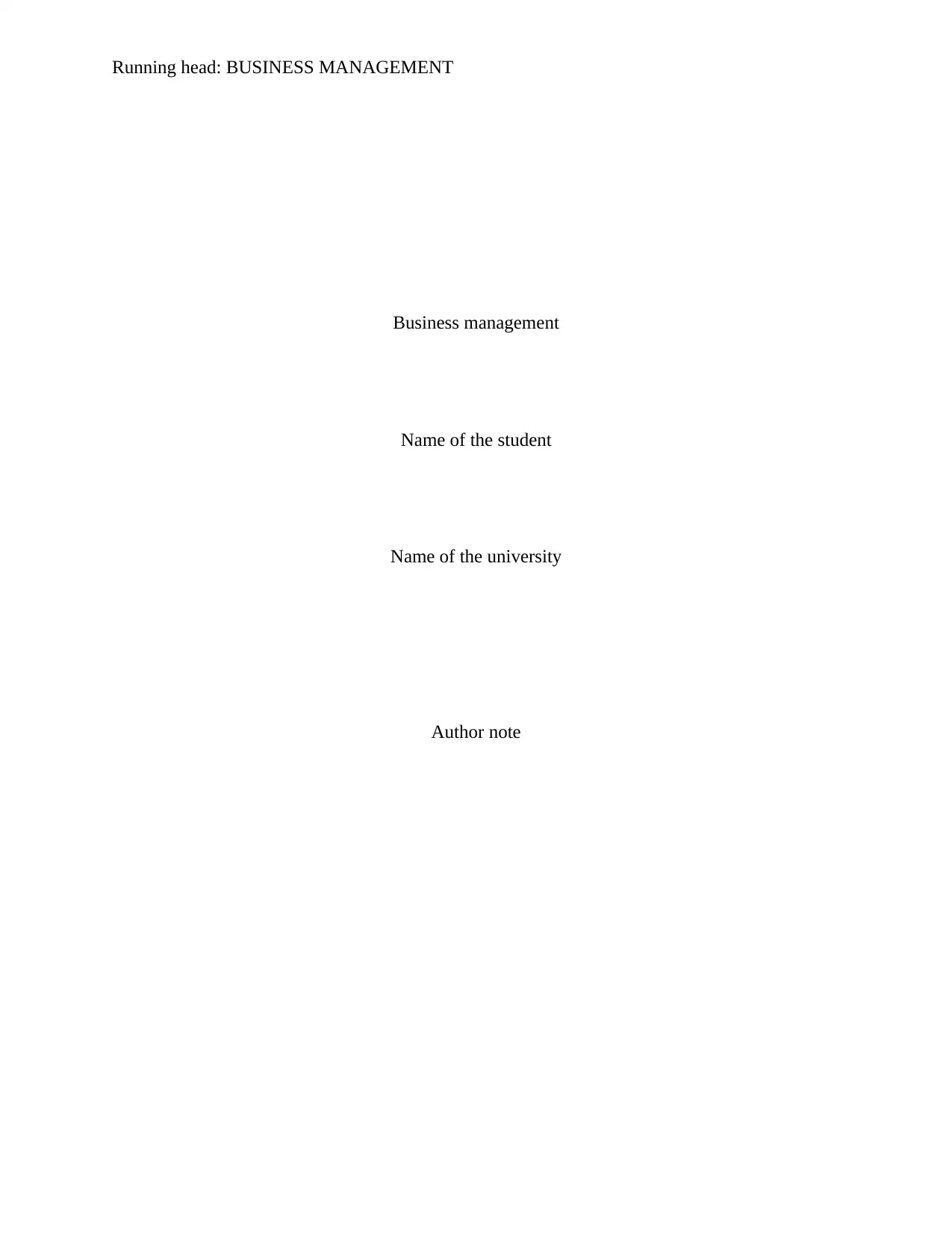
Running head: BUSINESS MANAGEMENT
Business management
Name of the student
Name of the university
Author note
Business management
Name of the student
Name of the university
Author note
Secure Best Marks with AI Grader
Need help grading? Try our AI Grader for instant feedback on your assignments.
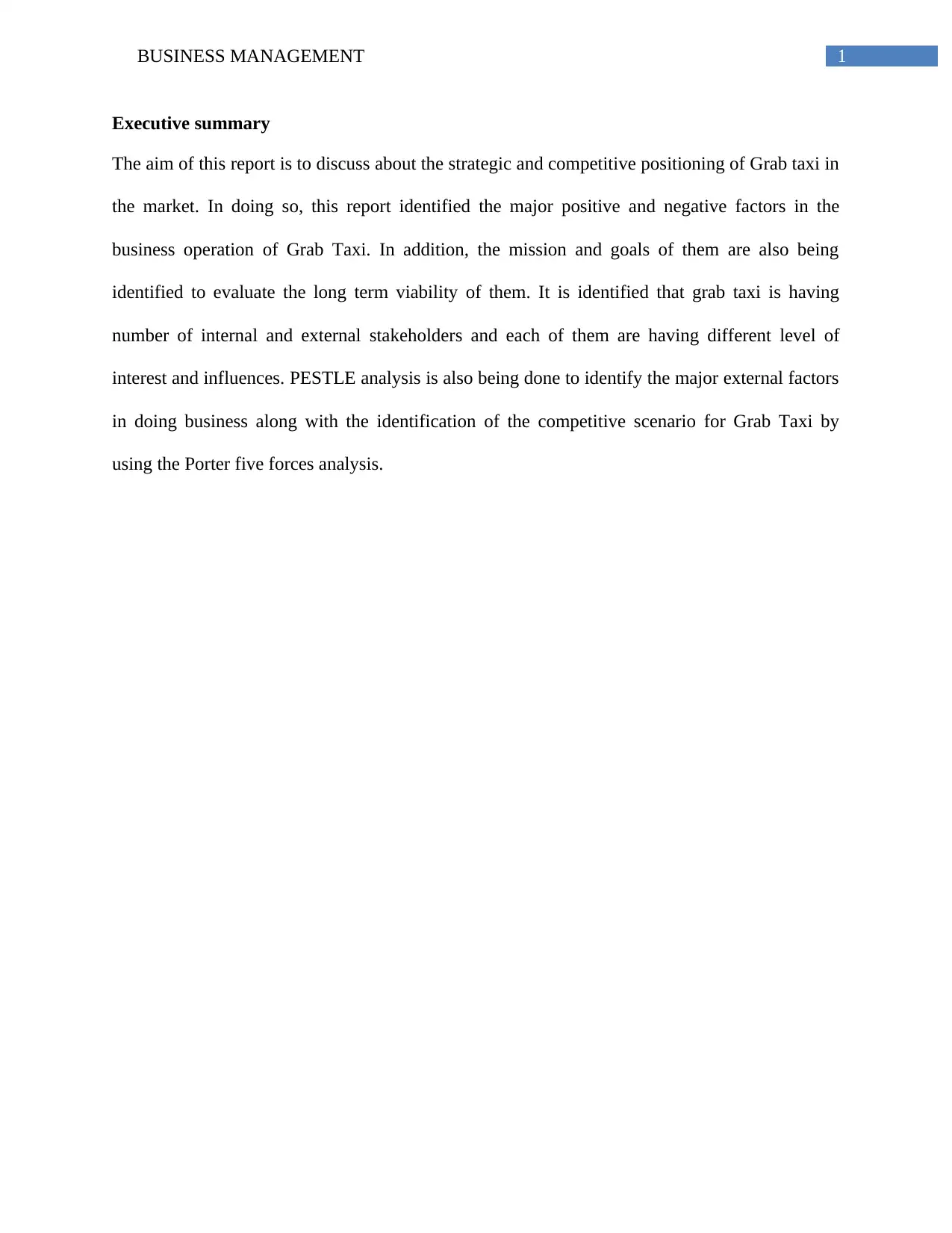
1BUSINESS MANAGEMENT
Executive summary
The aim of this report is to discuss about the strategic and competitive positioning of Grab taxi in
the market. In doing so, this report identified the major positive and negative factors in the
business operation of Grab Taxi. In addition, the mission and goals of them are also being
identified to evaluate the long term viability of them. It is identified that grab taxi is having
number of internal and external stakeholders and each of them are having different level of
interest and influences. PESTLE analysis is also being done to identify the major external factors
in doing business along with the identification of the competitive scenario for Grab Taxi by
using the Porter five forces analysis.
Executive summary
The aim of this report is to discuss about the strategic and competitive positioning of Grab taxi in
the market. In doing so, this report identified the major positive and negative factors in the
business operation of Grab Taxi. In addition, the mission and goals of them are also being
identified to evaluate the long term viability of them. It is identified that grab taxi is having
number of internal and external stakeholders and each of them are having different level of
interest and influences. PESTLE analysis is also being done to identify the major external factors
in doing business along with the identification of the competitive scenario for Grab Taxi by
using the Porter five forces analysis.
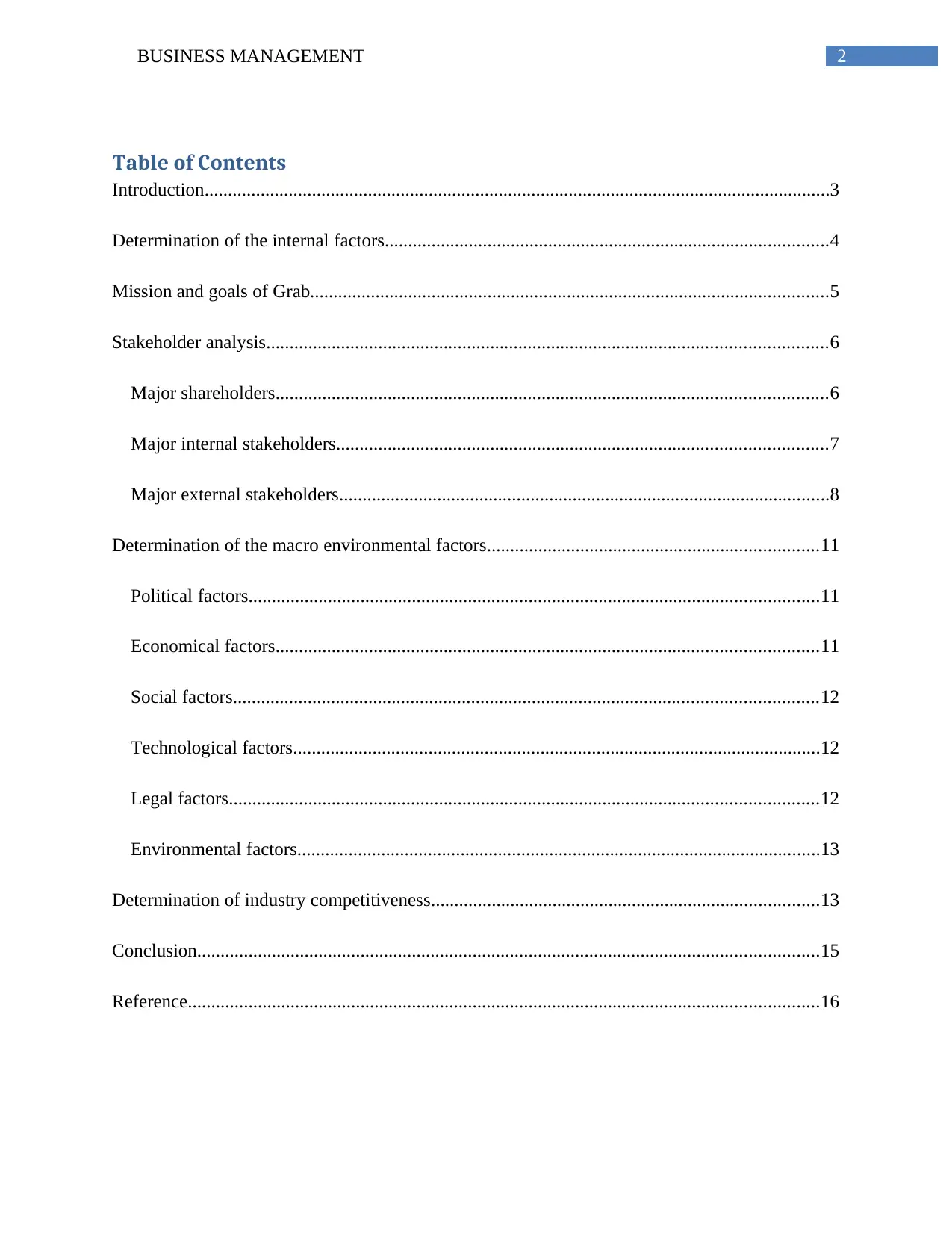
2BUSINESS MANAGEMENT
Table of Contents
Introduction......................................................................................................................................3
Determination of the internal factors...............................................................................................4
Mission and goals of Grab...............................................................................................................5
Stakeholder analysis........................................................................................................................6
Major shareholders......................................................................................................................6
Major internal stakeholders.........................................................................................................7
Major external stakeholders.........................................................................................................8
Determination of the macro environmental factors.......................................................................11
Political factors..........................................................................................................................11
Economical factors....................................................................................................................11
Social factors.............................................................................................................................12
Technological factors.................................................................................................................12
Legal factors..............................................................................................................................12
Environmental factors................................................................................................................13
Determination of industry competitiveness...................................................................................13
Conclusion.....................................................................................................................................15
Reference.......................................................................................................................................16
Table of Contents
Introduction......................................................................................................................................3
Determination of the internal factors...............................................................................................4
Mission and goals of Grab...............................................................................................................5
Stakeholder analysis........................................................................................................................6
Major shareholders......................................................................................................................6
Major internal stakeholders.........................................................................................................7
Major external stakeholders.........................................................................................................8
Determination of the macro environmental factors.......................................................................11
Political factors..........................................................................................................................11
Economical factors....................................................................................................................11
Social factors.............................................................................................................................12
Technological factors.................................................................................................................12
Legal factors..............................................................................................................................12
Environmental factors................................................................................................................13
Determination of industry competitiveness...................................................................................13
Conclusion.....................................................................................................................................15
Reference.......................................................................................................................................16

3BUSINESS MANAGEMENT
Secure Best Marks with AI Grader
Need help grading? Try our AI Grader for instant feedback on your assignments.
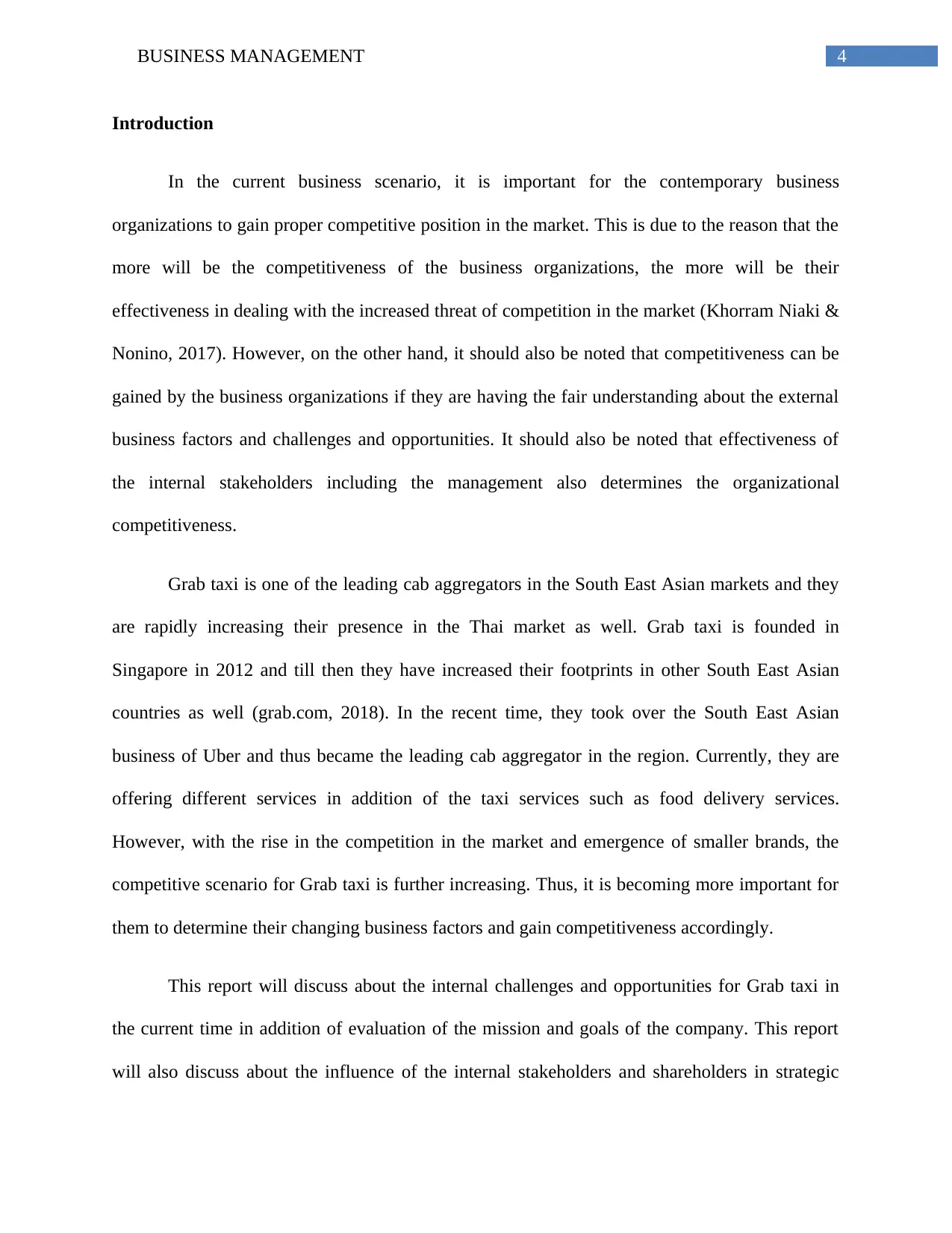
4BUSINESS MANAGEMENT
Introduction
In the current business scenario, it is important for the contemporary business
organizations to gain proper competitive position in the market. This is due to the reason that the
more will be the competitiveness of the business organizations, the more will be their
effectiveness in dealing with the increased threat of competition in the market (Khorram Niaki &
Nonino, 2017). However, on the other hand, it should also be noted that competitiveness can be
gained by the business organizations if they are having the fair understanding about the external
business factors and challenges and opportunities. It should also be noted that effectiveness of
the internal stakeholders including the management also determines the organizational
competitiveness.
Grab taxi is one of the leading cab aggregators in the South East Asian markets and they
are rapidly increasing their presence in the Thai market as well. Grab taxi is founded in
Singapore in 2012 and till then they have increased their footprints in other South East Asian
countries as well (grab.com, 2018). In the recent time, they took over the South East Asian
business of Uber and thus became the leading cab aggregator in the region. Currently, they are
offering different services in addition of the taxi services such as food delivery services.
However, with the rise in the competition in the market and emergence of smaller brands, the
competitive scenario for Grab taxi is further increasing. Thus, it is becoming more important for
them to determine their changing business factors and gain competitiveness accordingly.
This report will discuss about the internal challenges and opportunities for Grab taxi in
the current time in addition of evaluation of the mission and goals of the company. This report
will also discuss about the influence of the internal stakeholders and shareholders in strategic
Introduction
In the current business scenario, it is important for the contemporary business
organizations to gain proper competitive position in the market. This is due to the reason that the
more will be the competitiveness of the business organizations, the more will be their
effectiveness in dealing with the increased threat of competition in the market (Khorram Niaki &
Nonino, 2017). However, on the other hand, it should also be noted that competitiveness can be
gained by the business organizations if they are having the fair understanding about the external
business factors and challenges and opportunities. It should also be noted that effectiveness of
the internal stakeholders including the management also determines the organizational
competitiveness.
Grab taxi is one of the leading cab aggregators in the South East Asian markets and they
are rapidly increasing their presence in the Thai market as well. Grab taxi is founded in
Singapore in 2012 and till then they have increased their footprints in other South East Asian
countries as well (grab.com, 2018). In the recent time, they took over the South East Asian
business of Uber and thus became the leading cab aggregator in the region. Currently, they are
offering different services in addition of the taxi services such as food delivery services.
However, with the rise in the competition in the market and emergence of smaller brands, the
competitive scenario for Grab taxi is further increasing. Thus, it is becoming more important for
them to determine their changing business factors and gain competitiveness accordingly.
This report will discuss about the internal challenges and opportunities for Grab taxi in
the current time in addition of evaluation of the mission and goals of the company. This report
will also discuss about the influence of the internal stakeholders and shareholders in strategic
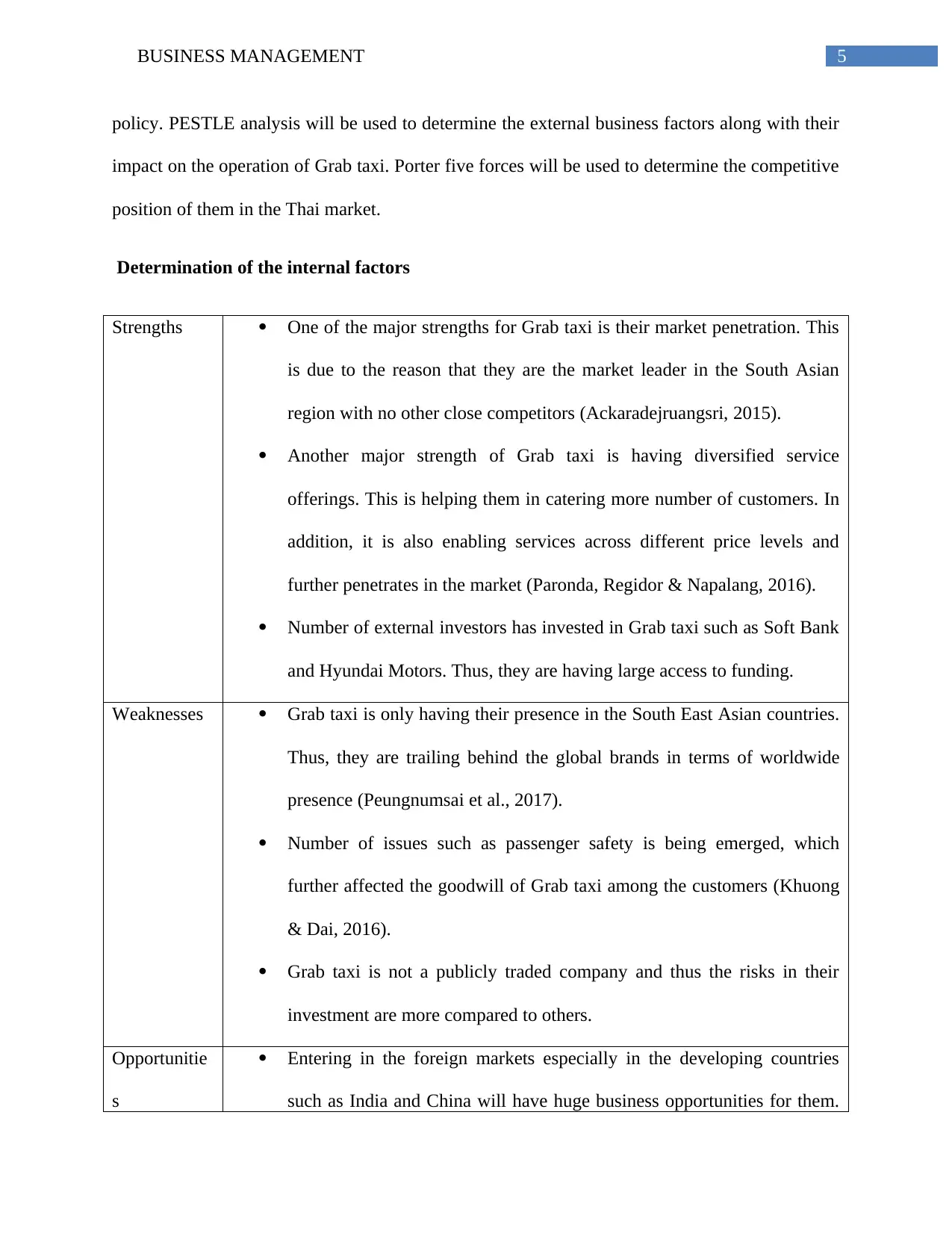
5BUSINESS MANAGEMENT
policy. PESTLE analysis will be used to determine the external business factors along with their
impact on the operation of Grab taxi. Porter five forces will be used to determine the competitive
position of them in the Thai market.
Determination of the internal factors
Strengths One of the major strengths for Grab taxi is their market penetration. This
is due to the reason that they are the market leader in the South Asian
region with no other close competitors (Ackaradejruangsri, 2015).
Another major strength of Grab taxi is having diversified service
offerings. This is helping them in catering more number of customers. In
addition, it is also enabling services across different price levels and
further penetrates in the market (Paronda, Regidor & Napalang, 2016).
Number of external investors has invested in Grab taxi such as Soft Bank
and Hyundai Motors. Thus, they are having large access to funding.
Weaknesses Grab taxi is only having their presence in the South East Asian countries.
Thus, they are trailing behind the global brands in terms of worldwide
presence (Peungnumsai et al., 2017).
Number of issues such as passenger safety is being emerged, which
further affected the goodwill of Grab taxi among the customers (Khuong
& Dai, 2016).
Grab taxi is not a publicly traded company and thus the risks in their
investment are more compared to others.
Opportunitie
s
Entering in the foreign markets especially in the developing countries
such as India and China will have huge business opportunities for them.
policy. PESTLE analysis will be used to determine the external business factors along with their
impact on the operation of Grab taxi. Porter five forces will be used to determine the competitive
position of them in the Thai market.
Determination of the internal factors
Strengths One of the major strengths for Grab taxi is their market penetration. This
is due to the reason that they are the market leader in the South Asian
region with no other close competitors (Ackaradejruangsri, 2015).
Another major strength of Grab taxi is having diversified service
offerings. This is helping them in catering more number of customers. In
addition, it is also enabling services across different price levels and
further penetrates in the market (Paronda, Regidor & Napalang, 2016).
Number of external investors has invested in Grab taxi such as Soft Bank
and Hyundai Motors. Thus, they are having large access to funding.
Weaknesses Grab taxi is only having their presence in the South East Asian countries.
Thus, they are trailing behind the global brands in terms of worldwide
presence (Peungnumsai et al., 2017).
Number of issues such as passenger safety is being emerged, which
further affected the goodwill of Grab taxi among the customers (Khuong
& Dai, 2016).
Grab taxi is not a publicly traded company and thus the risks in their
investment are more compared to others.
Opportunitie
s
Entering in the foreign markets especially in the developing countries
such as India and China will have huge business opportunities for them.
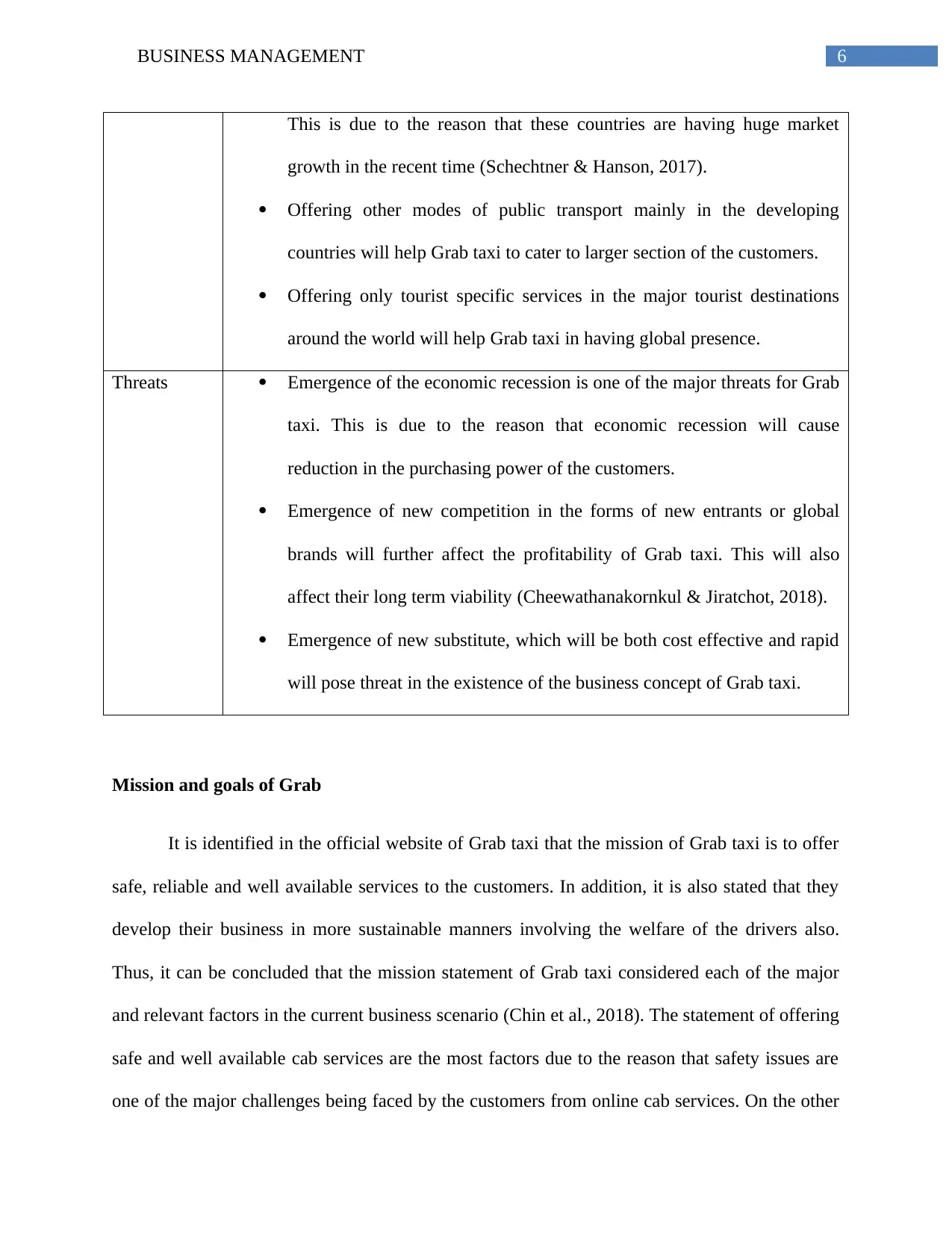
6BUSINESS MANAGEMENT
This is due to the reason that these countries are having huge market
growth in the recent time (Schechtner & Hanson, 2017).
Offering other modes of public transport mainly in the developing
countries will help Grab taxi to cater to larger section of the customers.
Offering only tourist specific services in the major tourist destinations
around the world will help Grab taxi in having global presence.
Threats Emergence of the economic recession is one of the major threats for Grab
taxi. This is due to the reason that economic recession will cause
reduction in the purchasing power of the customers.
Emergence of new competition in the forms of new entrants or global
brands will further affect the profitability of Grab taxi. This will also
affect their long term viability (Cheewathanakornkul & Jiratchot, 2018).
Emergence of new substitute, which will be both cost effective and rapid
will pose threat in the existence of the business concept of Grab taxi.
Mission and goals of Grab
It is identified in the official website of Grab taxi that the mission of Grab taxi is to offer
safe, reliable and well available services to the customers. In addition, it is also stated that they
develop their business in more sustainable manners involving the welfare of the drivers also.
Thus, it can be concluded that the mission statement of Grab taxi considered each of the major
and relevant factors in the current business scenario (Chin et al., 2018). The statement of offering
safe and well available cab services are the most factors due to the reason that safety issues are
one of the major challenges being faced by the customers from online cab services. On the other
This is due to the reason that these countries are having huge market
growth in the recent time (Schechtner & Hanson, 2017).
Offering other modes of public transport mainly in the developing
countries will help Grab taxi to cater to larger section of the customers.
Offering only tourist specific services in the major tourist destinations
around the world will help Grab taxi in having global presence.
Threats Emergence of the economic recession is one of the major threats for Grab
taxi. This is due to the reason that economic recession will cause
reduction in the purchasing power of the customers.
Emergence of new competition in the forms of new entrants or global
brands will further affect the profitability of Grab taxi. This will also
affect their long term viability (Cheewathanakornkul & Jiratchot, 2018).
Emergence of new substitute, which will be both cost effective and rapid
will pose threat in the existence of the business concept of Grab taxi.
Mission and goals of Grab
It is identified in the official website of Grab taxi that the mission of Grab taxi is to offer
safe, reliable and well available services to the customers. In addition, it is also stated that they
develop their business in more sustainable manners involving the welfare of the drivers also.
Thus, it can be concluded that the mission statement of Grab taxi considered each of the major
and relevant factors in the current business scenario (Chin et al., 2018). The statement of offering
safe and well available cab services are the most factors due to the reason that safety issues are
one of the major challenges being faced by the customers from online cab services. On the other
Paraphrase This Document
Need a fresh take? Get an instant paraphrase of this document with our AI Paraphraser
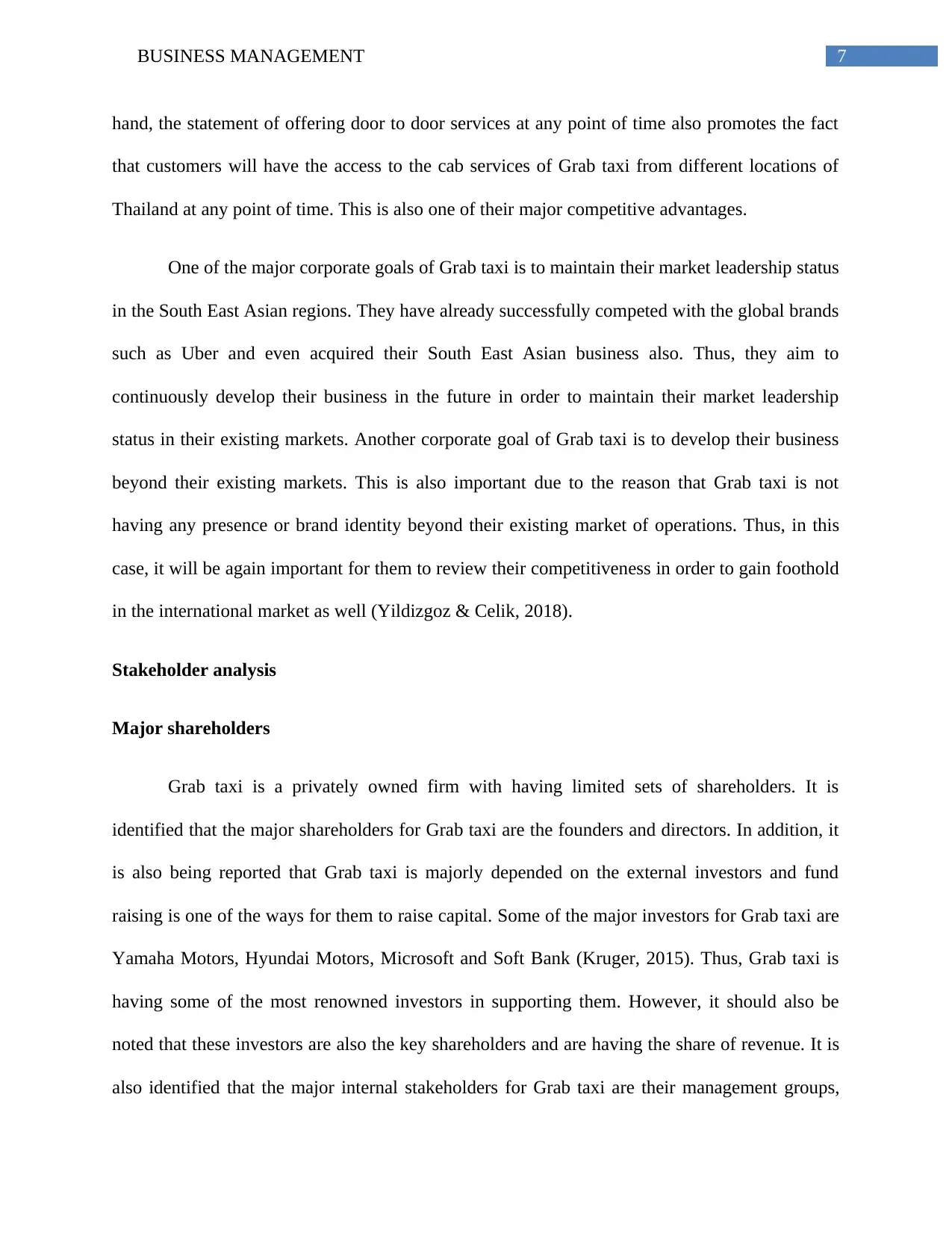
7BUSINESS MANAGEMENT
hand, the statement of offering door to door services at any point of time also promotes the fact
that customers will have the access to the cab services of Grab taxi from different locations of
Thailand at any point of time. This is also one of their major competitive advantages.
One of the major corporate goals of Grab taxi is to maintain their market leadership status
in the South East Asian regions. They have already successfully competed with the global brands
such as Uber and even acquired their South East Asian business also. Thus, they aim to
continuously develop their business in the future in order to maintain their market leadership
status in their existing markets. Another corporate goal of Grab taxi is to develop their business
beyond their existing markets. This is also important due to the reason that Grab taxi is not
having any presence or brand identity beyond their existing market of operations. Thus, in this
case, it will be again important for them to review their competitiveness in order to gain foothold
in the international market as well (Yildizgoz & Celik, 2018).
Stakeholder analysis
Major shareholders
Grab taxi is a privately owned firm with having limited sets of shareholders. It is
identified that the major shareholders for Grab taxi are the founders and directors. In addition, it
is also being reported that Grab taxi is majorly depended on the external investors and fund
raising is one of the ways for them to raise capital. Some of the major investors for Grab taxi are
Yamaha Motors, Hyundai Motors, Microsoft and Soft Bank (Kruger, 2015). Thus, Grab taxi is
having some of the most renowned investors in supporting them. However, it should also be
noted that these investors are also the key shareholders and are having the share of revenue. It is
also identified that the major internal stakeholders for Grab taxi are their management groups,
hand, the statement of offering door to door services at any point of time also promotes the fact
that customers will have the access to the cab services of Grab taxi from different locations of
Thailand at any point of time. This is also one of their major competitive advantages.
One of the major corporate goals of Grab taxi is to maintain their market leadership status
in the South East Asian regions. They have already successfully competed with the global brands
such as Uber and even acquired their South East Asian business also. Thus, they aim to
continuously develop their business in the future in order to maintain their market leadership
status in their existing markets. Another corporate goal of Grab taxi is to develop their business
beyond their existing markets. This is also important due to the reason that Grab taxi is not
having any presence or brand identity beyond their existing market of operations. Thus, in this
case, it will be again important for them to review their competitiveness in order to gain foothold
in the international market as well (Yildizgoz & Celik, 2018).
Stakeholder analysis
Major shareholders
Grab taxi is a privately owned firm with having limited sets of shareholders. It is
identified that the major shareholders for Grab taxi are the founders and directors. In addition, it
is also being reported that Grab taxi is majorly depended on the external investors and fund
raising is one of the ways for them to raise capital. Some of the major investors for Grab taxi are
Yamaha Motors, Hyundai Motors, Microsoft and Soft Bank (Kruger, 2015). Thus, Grab taxi is
having some of the most renowned investors in supporting them. However, it should also be
noted that these investors are also the key shareholders and are having the share of revenue. It is
also identified that the major internal stakeholders for Grab taxi are their management groups,
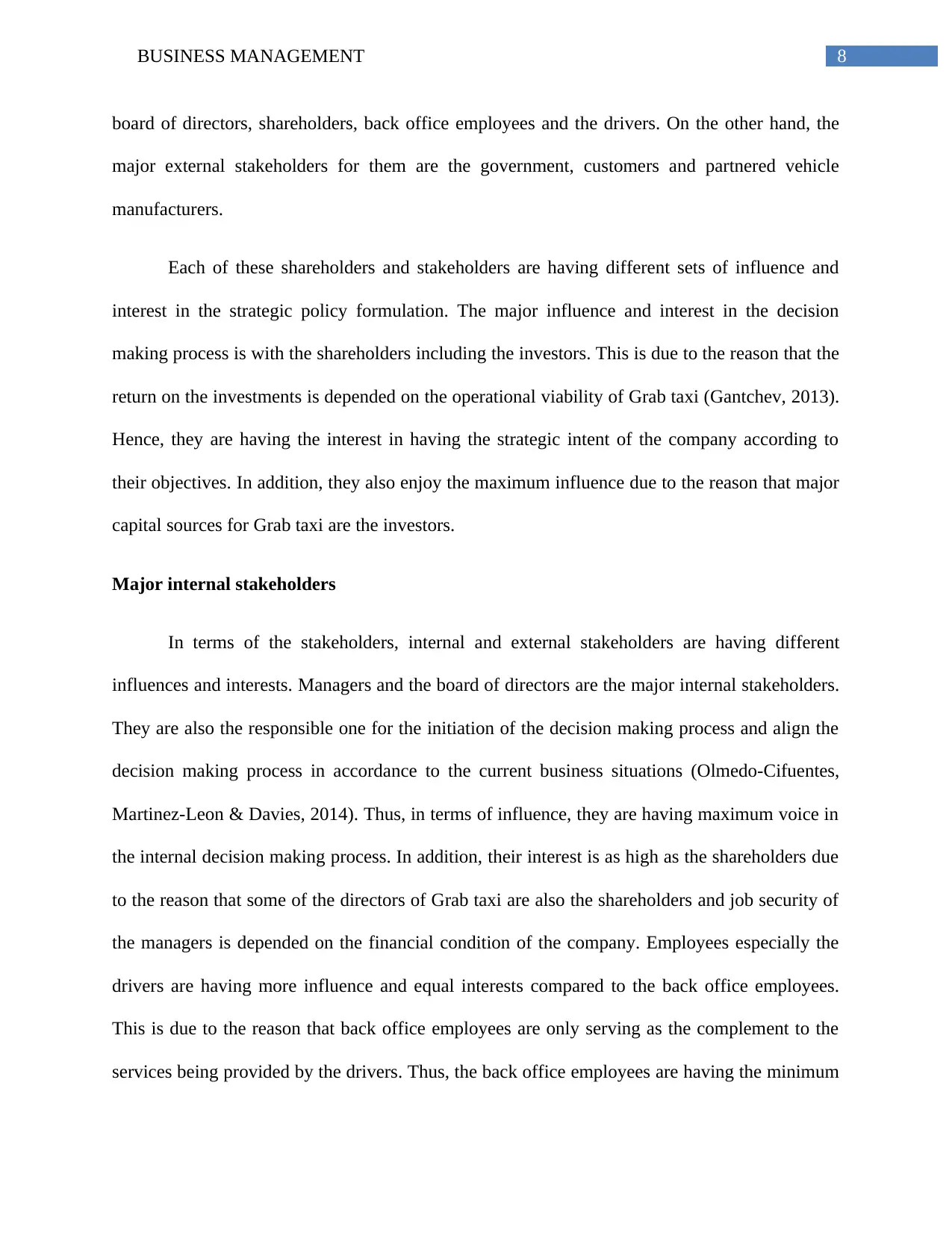
8BUSINESS MANAGEMENT
board of directors, shareholders, back office employees and the drivers. On the other hand, the
major external stakeholders for them are the government, customers and partnered vehicle
manufacturers.
Each of these shareholders and stakeholders are having different sets of influence and
interest in the strategic policy formulation. The major influence and interest in the decision
making process is with the shareholders including the investors. This is due to the reason that the
return on the investments is depended on the operational viability of Grab taxi (Gantchev, 2013).
Hence, they are having the interest in having the strategic intent of the company according to
their objectives. In addition, they also enjoy the maximum influence due to the reason that major
capital sources for Grab taxi are the investors.
Major internal stakeholders
In terms of the stakeholders, internal and external stakeholders are having different
influences and interests. Managers and the board of directors are the major internal stakeholders.
They are also the responsible one for the initiation of the decision making process and align the
decision making process in accordance to the current business situations (Olmedo-Cifuentes,
Martinez-Leon & Davies, 2014). Thus, in terms of influence, they are having maximum voice in
the internal decision making process. In addition, their interest is as high as the shareholders due
to the reason that some of the directors of Grab taxi are also the shareholders and job security of
the managers is depended on the financial condition of the company. Employees especially the
drivers are having more influence and equal interests compared to the back office employees.
This is due to the reason that back office employees are only serving as the complement to the
services being provided by the drivers. Thus, the back office employees are having the minimum
board of directors, shareholders, back office employees and the drivers. On the other hand, the
major external stakeholders for them are the government, customers and partnered vehicle
manufacturers.
Each of these shareholders and stakeholders are having different sets of influence and
interest in the strategic policy formulation. The major influence and interest in the decision
making process is with the shareholders including the investors. This is due to the reason that the
return on the investments is depended on the operational viability of Grab taxi (Gantchev, 2013).
Hence, they are having the interest in having the strategic intent of the company according to
their objectives. In addition, they also enjoy the maximum influence due to the reason that major
capital sources for Grab taxi are the investors.
Major internal stakeholders
In terms of the stakeholders, internal and external stakeholders are having different
influences and interests. Managers and the board of directors are the major internal stakeholders.
They are also the responsible one for the initiation of the decision making process and align the
decision making process in accordance to the current business situations (Olmedo-Cifuentes,
Martinez-Leon & Davies, 2014). Thus, in terms of influence, they are having maximum voice in
the internal decision making process. In addition, their interest is as high as the shareholders due
to the reason that some of the directors of Grab taxi are also the shareholders and job security of
the managers is depended on the financial condition of the company. Employees especially the
drivers are having more influence and equal interests compared to the back office employees.
This is due to the reason that back office employees are only serving as the complement to the
services being provided by the drivers. Thus, the back office employees are having the minimum
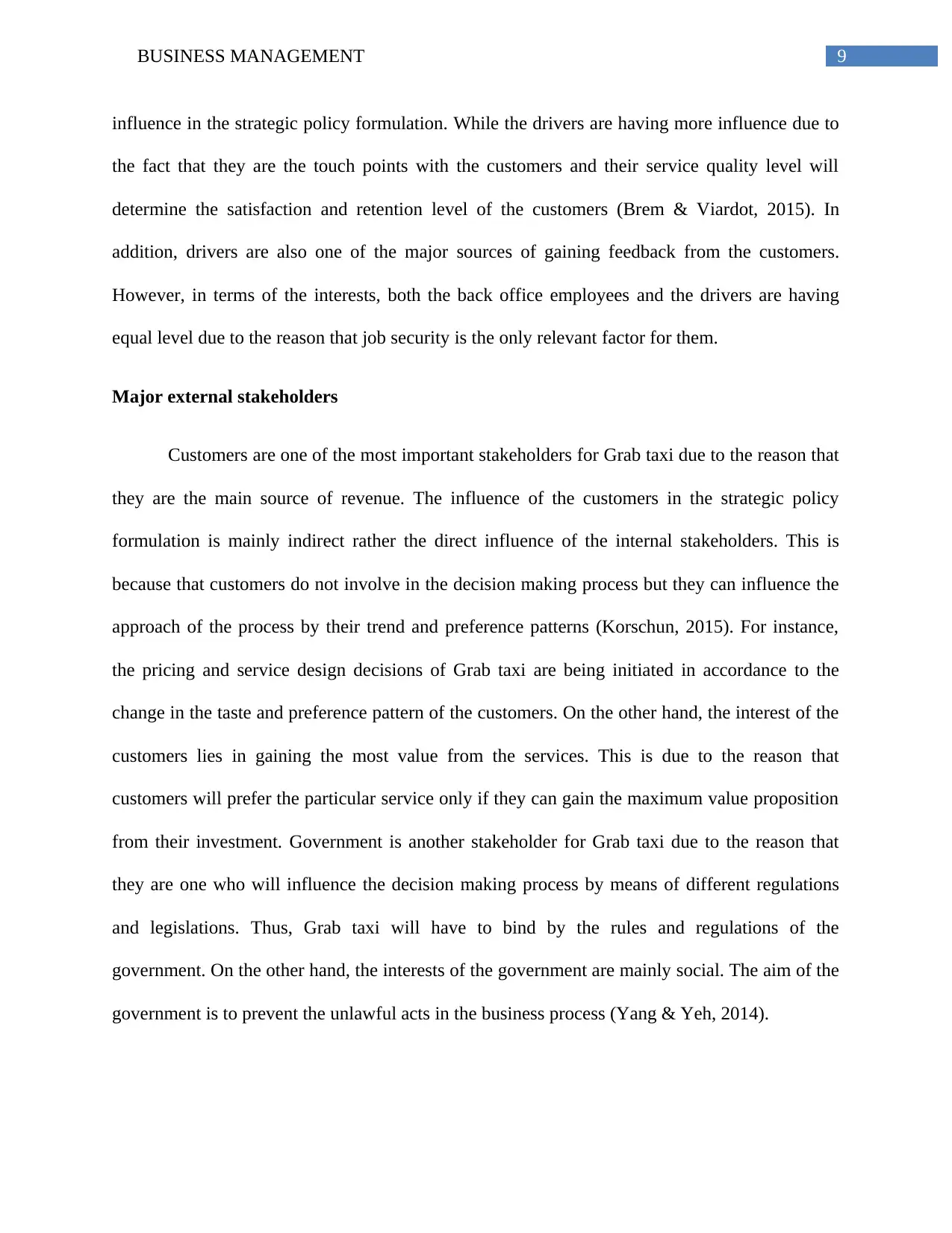
9BUSINESS MANAGEMENT
influence in the strategic policy formulation. While the drivers are having more influence due to
the fact that they are the touch points with the customers and their service quality level will
determine the satisfaction and retention level of the customers (Brem & Viardot, 2015). In
addition, drivers are also one of the major sources of gaining feedback from the customers.
However, in terms of the interests, both the back office employees and the drivers are having
equal level due to the reason that job security is the only relevant factor for them.
Major external stakeholders
Customers are one of the most important stakeholders for Grab taxi due to the reason that
they are the main source of revenue. The influence of the customers in the strategic policy
formulation is mainly indirect rather the direct influence of the internal stakeholders. This is
because that customers do not involve in the decision making process but they can influence the
approach of the process by their trend and preference patterns (Korschun, 2015). For instance,
the pricing and service design decisions of Grab taxi are being initiated in accordance to the
change in the taste and preference pattern of the customers. On the other hand, the interest of the
customers lies in gaining the most value from the services. This is due to the reason that
customers will prefer the particular service only if they can gain the maximum value proposition
from their investment. Government is another stakeholder for Grab taxi due to the reason that
they are one who will influence the decision making process by means of different regulations
and legislations. Thus, Grab taxi will have to bind by the rules and regulations of the
government. On the other hand, the interests of the government are mainly social. The aim of the
government is to prevent the unlawful acts in the business process (Yang & Yeh, 2014).
influence in the strategic policy formulation. While the drivers are having more influence due to
the fact that they are the touch points with the customers and their service quality level will
determine the satisfaction and retention level of the customers (Brem & Viardot, 2015). In
addition, drivers are also one of the major sources of gaining feedback from the customers.
However, in terms of the interests, both the back office employees and the drivers are having
equal level due to the reason that job security is the only relevant factor for them.
Major external stakeholders
Customers are one of the most important stakeholders for Grab taxi due to the reason that
they are the main source of revenue. The influence of the customers in the strategic policy
formulation is mainly indirect rather the direct influence of the internal stakeholders. This is
because that customers do not involve in the decision making process but they can influence the
approach of the process by their trend and preference patterns (Korschun, 2015). For instance,
the pricing and service design decisions of Grab taxi are being initiated in accordance to the
change in the taste and preference pattern of the customers. On the other hand, the interest of the
customers lies in gaining the most value from the services. This is due to the reason that
customers will prefer the particular service only if they can gain the maximum value proposition
from their investment. Government is another stakeholder for Grab taxi due to the reason that
they are one who will influence the decision making process by means of different regulations
and legislations. Thus, Grab taxi will have to bind by the rules and regulations of the
government. On the other hand, the interests of the government are mainly social. The aim of the
government is to prevent the unlawful acts in the business process (Yang & Yeh, 2014).
Secure Best Marks with AI Grader
Need help grading? Try our AI Grader for instant feedback on your assignments.
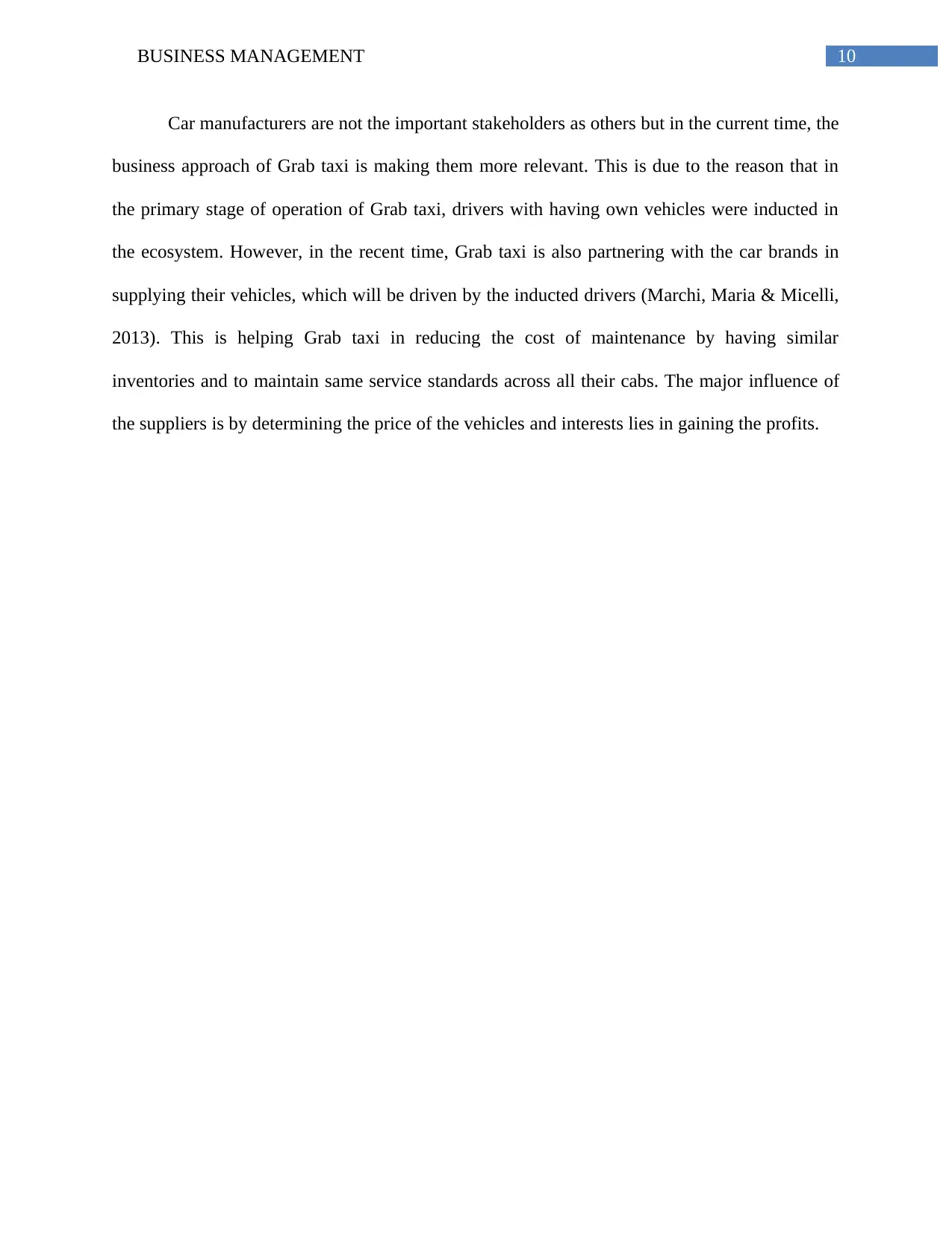
10BUSINESS MANAGEMENT
Car manufacturers are not the important stakeholders as others but in the current time, the
business approach of Grab taxi is making them more relevant. This is due to the reason that in
the primary stage of operation of Grab taxi, drivers with having own vehicles were inducted in
the ecosystem. However, in the recent time, Grab taxi is also partnering with the car brands in
supplying their vehicles, which will be driven by the inducted drivers (Marchi, Maria & Micelli,
2013). This is helping Grab taxi in reducing the cost of maintenance by having similar
inventories and to maintain same service standards across all their cabs. The major influence of
the suppliers is by determining the price of the vehicles and interests lies in gaining the profits.
Car manufacturers are not the important stakeholders as others but in the current time, the
business approach of Grab taxi is making them more relevant. This is due to the reason that in
the primary stage of operation of Grab taxi, drivers with having own vehicles were inducted in
the ecosystem. However, in the recent time, Grab taxi is also partnering with the car brands in
supplying their vehicles, which will be driven by the inducted drivers (Marchi, Maria & Micelli,
2013). This is helping Grab taxi in reducing the cost of maintenance by having similar
inventories and to maintain same service standards across all their cabs. The major influence of
the suppliers is by determining the price of the vehicles and interests lies in gaining the profits.
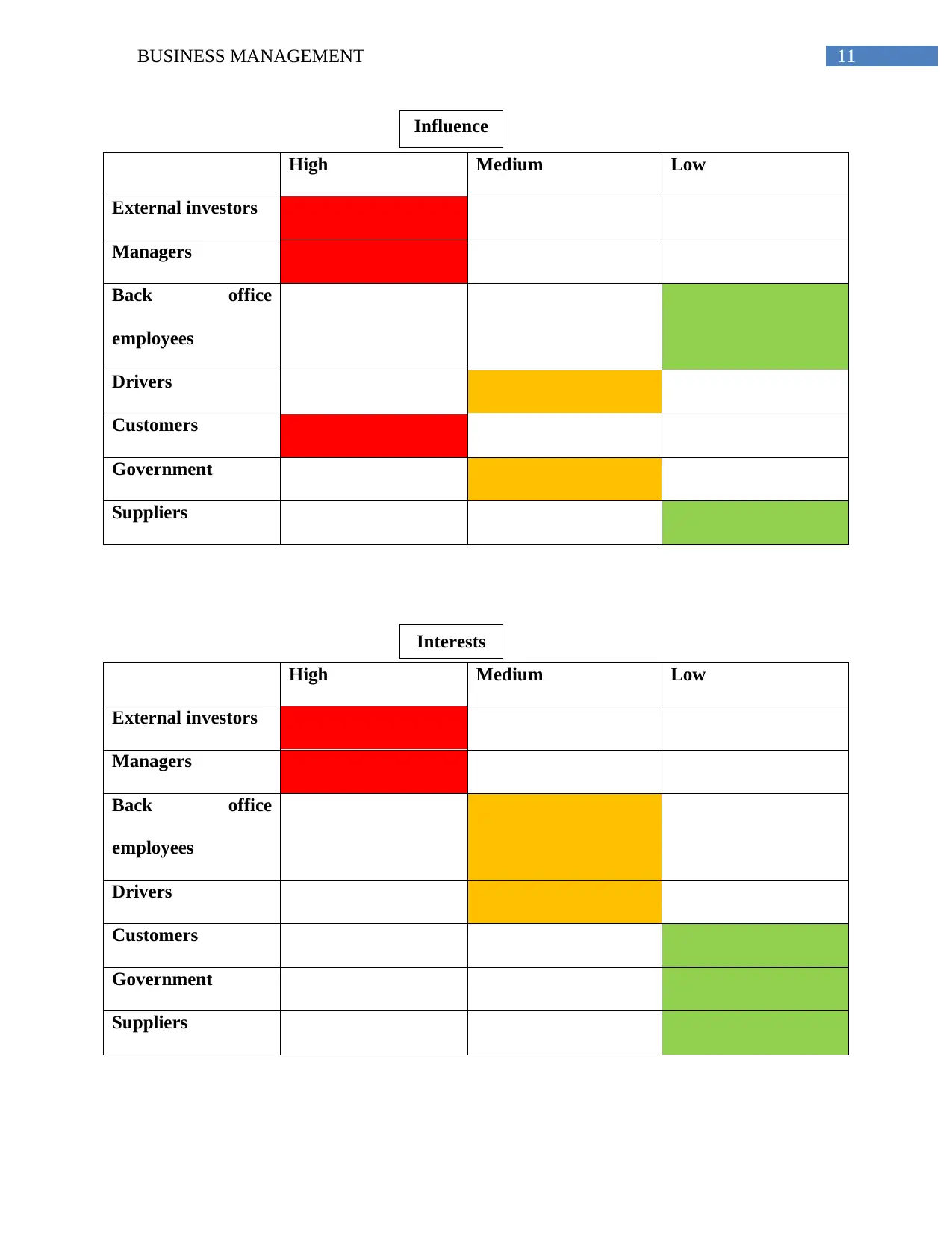
11BUSINESS MANAGEMENT
High Medium Low
External investors
Managers
Back office
employees
Drivers
Customers
Government
Suppliers
High Medium Low
External investors
Managers
Back office
employees
Drivers
Customers
Government
Suppliers
Influence
Interests
High Medium Low
External investors
Managers
Back office
employees
Drivers
Customers
Government
Suppliers
High Medium Low
External investors
Managers
Back office
employees
Drivers
Customers
Government
Suppliers
Influence
Interests
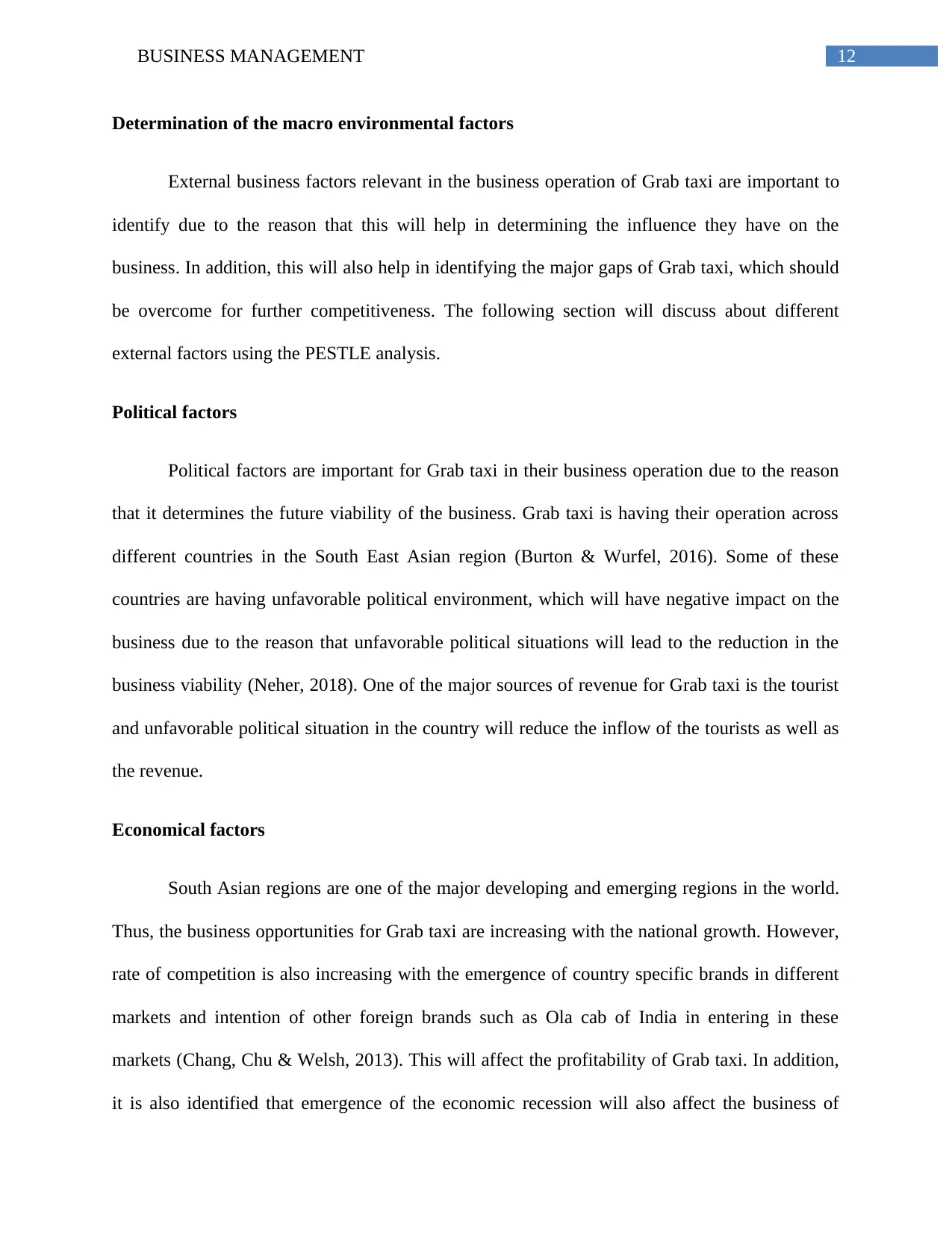
12BUSINESS MANAGEMENT
Determination of the macro environmental factors
External business factors relevant in the business operation of Grab taxi are important to
identify due to the reason that this will help in determining the influence they have on the
business. In addition, this will also help in identifying the major gaps of Grab taxi, which should
be overcome for further competitiveness. The following section will discuss about different
external factors using the PESTLE analysis.
Political factors
Political factors are important for Grab taxi in their business operation due to the reason
that it determines the future viability of the business. Grab taxi is having their operation across
different countries in the South East Asian region (Burton & Wurfel, 2016). Some of these
countries are having unfavorable political environment, which will have negative impact on the
business due to the reason that unfavorable political situations will lead to the reduction in the
business viability (Neher, 2018). One of the major sources of revenue for Grab taxi is the tourist
and unfavorable political situation in the country will reduce the inflow of the tourists as well as
the revenue.
Economical factors
South Asian regions are one of the major developing and emerging regions in the world.
Thus, the business opportunities for Grab taxi are increasing with the national growth. However,
rate of competition is also increasing with the emergence of country specific brands in different
markets and intention of other foreign brands such as Ola cab of India in entering in these
markets (Chang, Chu & Welsh, 2013). This will affect the profitability of Grab taxi. In addition,
it is also identified that emergence of the economic recession will also affect the business of
Determination of the macro environmental factors
External business factors relevant in the business operation of Grab taxi are important to
identify due to the reason that this will help in determining the influence they have on the
business. In addition, this will also help in identifying the major gaps of Grab taxi, which should
be overcome for further competitiveness. The following section will discuss about different
external factors using the PESTLE analysis.
Political factors
Political factors are important for Grab taxi in their business operation due to the reason
that it determines the future viability of the business. Grab taxi is having their operation across
different countries in the South East Asian region (Burton & Wurfel, 2016). Some of these
countries are having unfavorable political environment, which will have negative impact on the
business due to the reason that unfavorable political situations will lead to the reduction in the
business viability (Neher, 2018). One of the major sources of revenue for Grab taxi is the tourist
and unfavorable political situation in the country will reduce the inflow of the tourists as well as
the revenue.
Economical factors
South Asian regions are one of the major developing and emerging regions in the world.
Thus, the business opportunities for Grab taxi are increasing with the national growth. However,
rate of competition is also increasing with the emergence of country specific brands in different
markets and intention of other foreign brands such as Ola cab of India in entering in these
markets (Chang, Chu & Welsh, 2013). This will affect the profitability of Grab taxi. In addition,
it is also identified that emergence of the economic recession will also affect the business of
Paraphrase This Document
Need a fresh take? Get an instant paraphrase of this document with our AI Paraphraser
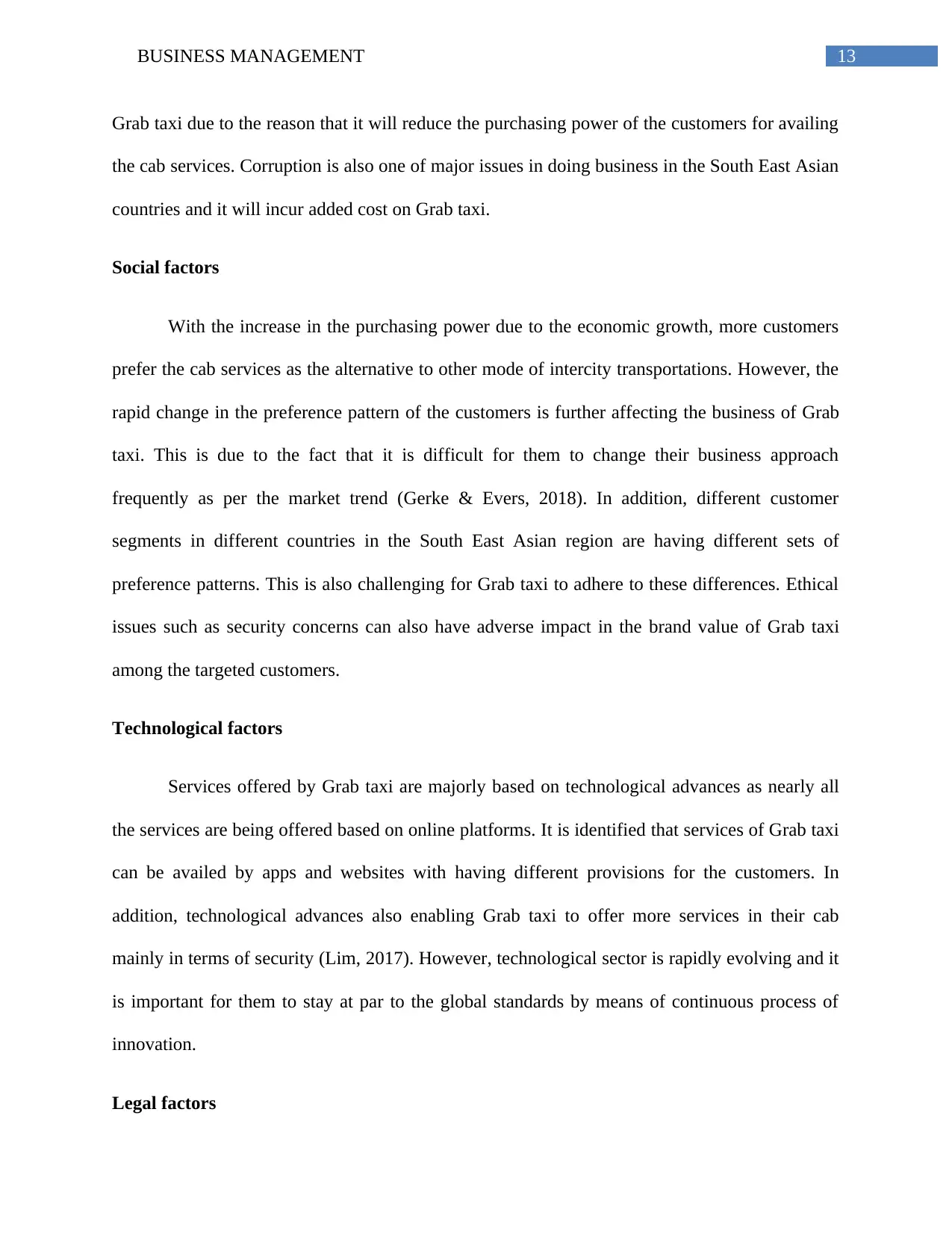
13BUSINESS MANAGEMENT
Grab taxi due to the reason that it will reduce the purchasing power of the customers for availing
the cab services. Corruption is also one of major issues in doing business in the South East Asian
countries and it will incur added cost on Grab taxi.
Social factors
With the increase in the purchasing power due to the economic growth, more customers
prefer the cab services as the alternative to other mode of intercity transportations. However, the
rapid change in the preference pattern of the customers is further affecting the business of Grab
taxi. This is due to the fact that it is difficult for them to change their business approach
frequently as per the market trend (Gerke & Evers, 2018). In addition, different customer
segments in different countries in the South East Asian region are having different sets of
preference patterns. This is also challenging for Grab taxi to adhere to these differences. Ethical
issues such as security concerns can also have adverse impact in the brand value of Grab taxi
among the targeted customers.
Technological factors
Services offered by Grab taxi are majorly based on technological advances as nearly all
the services are being offered based on online platforms. It is identified that services of Grab taxi
can be availed by apps and websites with having different provisions for the customers. In
addition, technological advances also enabling Grab taxi to offer more services in their cab
mainly in terms of security (Lim, 2017). However, technological sector is rapidly evolving and it
is important for them to stay at par to the global standards by means of continuous process of
innovation.
Legal factors
Grab taxi due to the reason that it will reduce the purchasing power of the customers for availing
the cab services. Corruption is also one of major issues in doing business in the South East Asian
countries and it will incur added cost on Grab taxi.
Social factors
With the increase in the purchasing power due to the economic growth, more customers
prefer the cab services as the alternative to other mode of intercity transportations. However, the
rapid change in the preference pattern of the customers is further affecting the business of Grab
taxi. This is due to the fact that it is difficult for them to change their business approach
frequently as per the market trend (Gerke & Evers, 2018). In addition, different customer
segments in different countries in the South East Asian region are having different sets of
preference patterns. This is also challenging for Grab taxi to adhere to these differences. Ethical
issues such as security concerns can also have adverse impact in the brand value of Grab taxi
among the targeted customers.
Technological factors
Services offered by Grab taxi are majorly based on technological advances as nearly all
the services are being offered based on online platforms. It is identified that services of Grab taxi
can be availed by apps and websites with having different provisions for the customers. In
addition, technological advances also enabling Grab taxi to offer more services in their cab
mainly in terms of security (Lim, 2017). However, technological sector is rapidly evolving and it
is important for them to stay at par to the global standards by means of continuous process of
innovation.
Legal factors
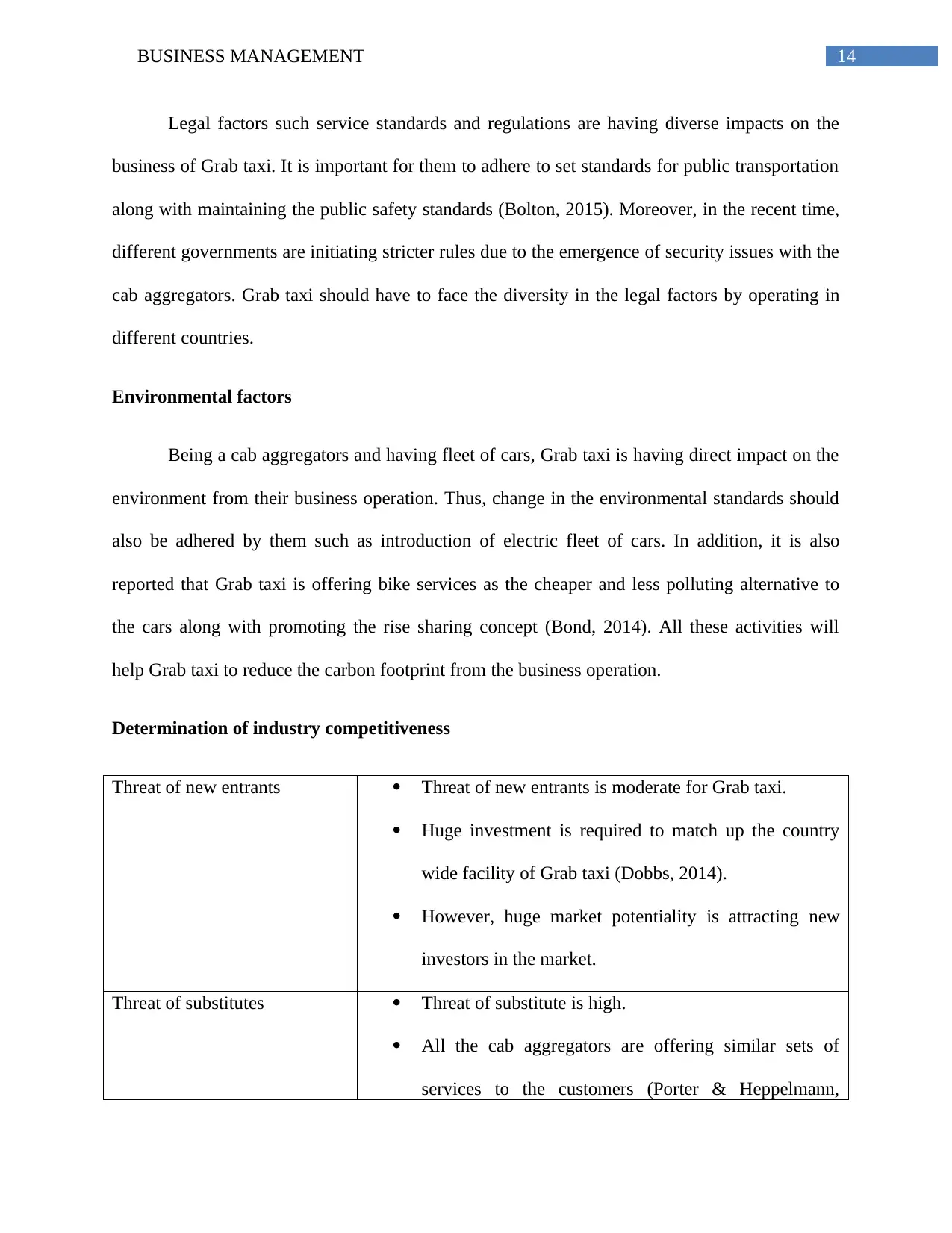
14BUSINESS MANAGEMENT
Legal factors such service standards and regulations are having diverse impacts on the
business of Grab taxi. It is important for them to adhere to set standards for public transportation
along with maintaining the public safety standards (Bolton, 2015). Moreover, in the recent time,
different governments are initiating stricter rules due to the emergence of security issues with the
cab aggregators. Grab taxi should have to face the diversity in the legal factors by operating in
different countries.
Environmental factors
Being a cab aggregators and having fleet of cars, Grab taxi is having direct impact on the
environment from their business operation. Thus, change in the environmental standards should
also be adhered by them such as introduction of electric fleet of cars. In addition, it is also
reported that Grab taxi is offering bike services as the cheaper and less polluting alternative to
the cars along with promoting the rise sharing concept (Bond, 2014). All these activities will
help Grab taxi to reduce the carbon footprint from the business operation.
Determination of industry competitiveness
Threat of new entrants Threat of new entrants is moderate for Grab taxi.
Huge investment is required to match up the country
wide facility of Grab taxi (Dobbs, 2014).
However, huge market potentiality is attracting new
investors in the market.
Threat of substitutes Threat of substitute is high.
All the cab aggregators are offering similar sets of
services to the customers (Porter & Heppelmann,
Legal factors such service standards and regulations are having diverse impacts on the
business of Grab taxi. It is important for them to adhere to set standards for public transportation
along with maintaining the public safety standards (Bolton, 2015). Moreover, in the recent time,
different governments are initiating stricter rules due to the emergence of security issues with the
cab aggregators. Grab taxi should have to face the diversity in the legal factors by operating in
different countries.
Environmental factors
Being a cab aggregators and having fleet of cars, Grab taxi is having direct impact on the
environment from their business operation. Thus, change in the environmental standards should
also be adhered by them such as introduction of electric fleet of cars. In addition, it is also
reported that Grab taxi is offering bike services as the cheaper and less polluting alternative to
the cars along with promoting the rise sharing concept (Bond, 2014). All these activities will
help Grab taxi to reduce the carbon footprint from the business operation.
Determination of industry competitiveness
Threat of new entrants Threat of new entrants is moderate for Grab taxi.
Huge investment is required to match up the country
wide facility of Grab taxi (Dobbs, 2014).
However, huge market potentiality is attracting new
investors in the market.
Threat of substitutes Threat of substitute is high.
All the cab aggregators are offering similar sets of
services to the customers (Porter & Heppelmann,
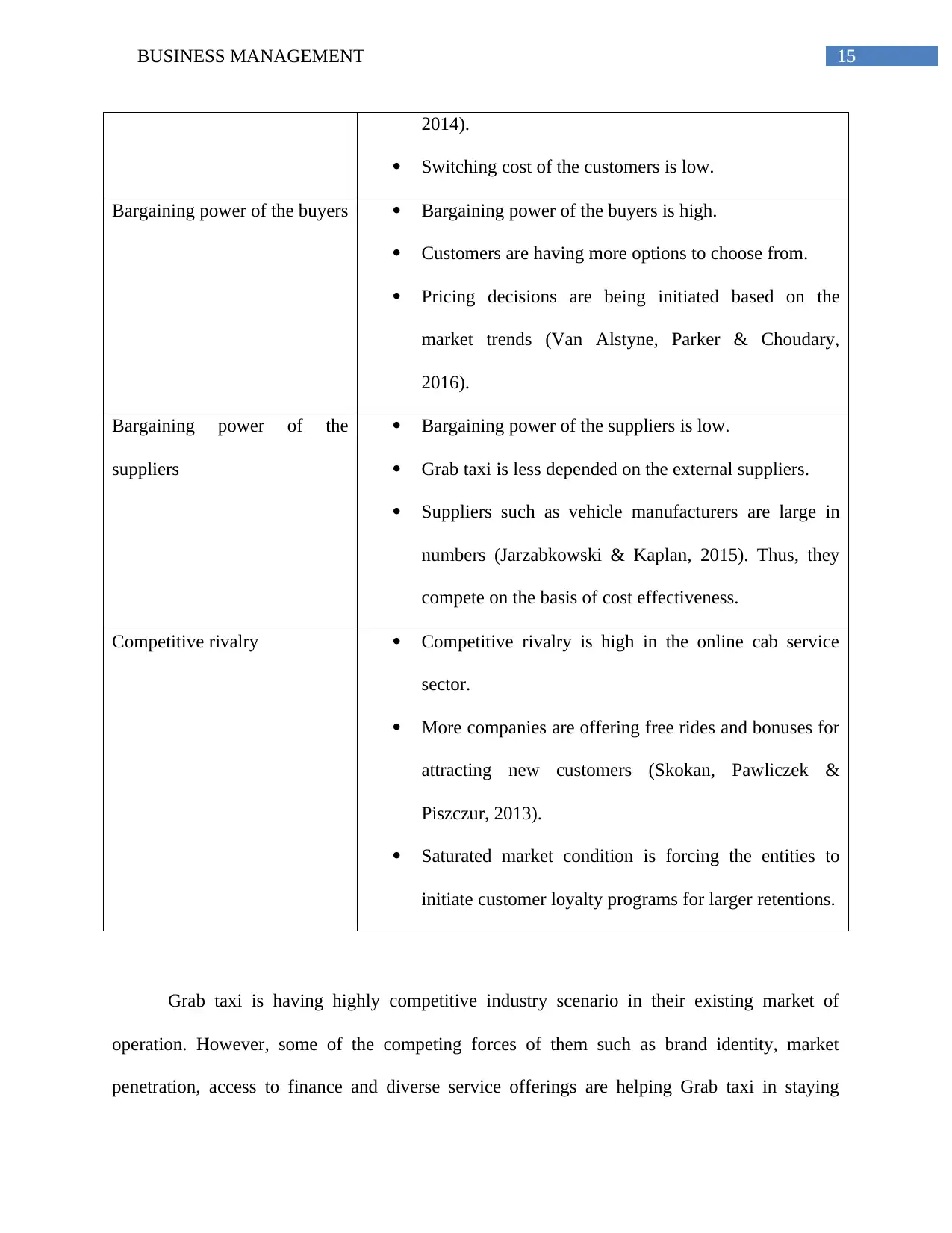
15BUSINESS MANAGEMENT
2014).
Switching cost of the customers is low.
Bargaining power of the buyers Bargaining power of the buyers is high.
Customers are having more options to choose from.
Pricing decisions are being initiated based on the
market trends (Van Alstyne, Parker & Choudary,
2016).
Bargaining power of the
suppliers
Bargaining power of the suppliers is low.
Grab taxi is less depended on the external suppliers.
Suppliers such as vehicle manufacturers are large in
numbers (Jarzabkowski & Kaplan, 2015). Thus, they
compete on the basis of cost effectiveness.
Competitive rivalry Competitive rivalry is high in the online cab service
sector.
More companies are offering free rides and bonuses for
attracting new customers (Skokan, Pawliczek &
Piszczur, 2013).
Saturated market condition is forcing the entities to
initiate customer loyalty programs for larger retentions.
Grab taxi is having highly competitive industry scenario in their existing market of
operation. However, some of the competing forces of them such as brand identity, market
penetration, access to finance and diverse service offerings are helping Grab taxi in staying
2014).
Switching cost of the customers is low.
Bargaining power of the buyers Bargaining power of the buyers is high.
Customers are having more options to choose from.
Pricing decisions are being initiated based on the
market trends (Van Alstyne, Parker & Choudary,
2016).
Bargaining power of the
suppliers
Bargaining power of the suppliers is low.
Grab taxi is less depended on the external suppliers.
Suppliers such as vehicle manufacturers are large in
numbers (Jarzabkowski & Kaplan, 2015). Thus, they
compete on the basis of cost effectiveness.
Competitive rivalry Competitive rivalry is high in the online cab service
sector.
More companies are offering free rides and bonuses for
attracting new customers (Skokan, Pawliczek &
Piszczur, 2013).
Saturated market condition is forcing the entities to
initiate customer loyalty programs for larger retentions.
Grab taxi is having highly competitive industry scenario in their existing market of
operation. However, some of the competing forces of them such as brand identity, market
penetration, access to finance and diverse service offerings are helping Grab taxi in staying
Secure Best Marks with AI Grader
Need help grading? Try our AI Grader for instant feedback on your assignments.
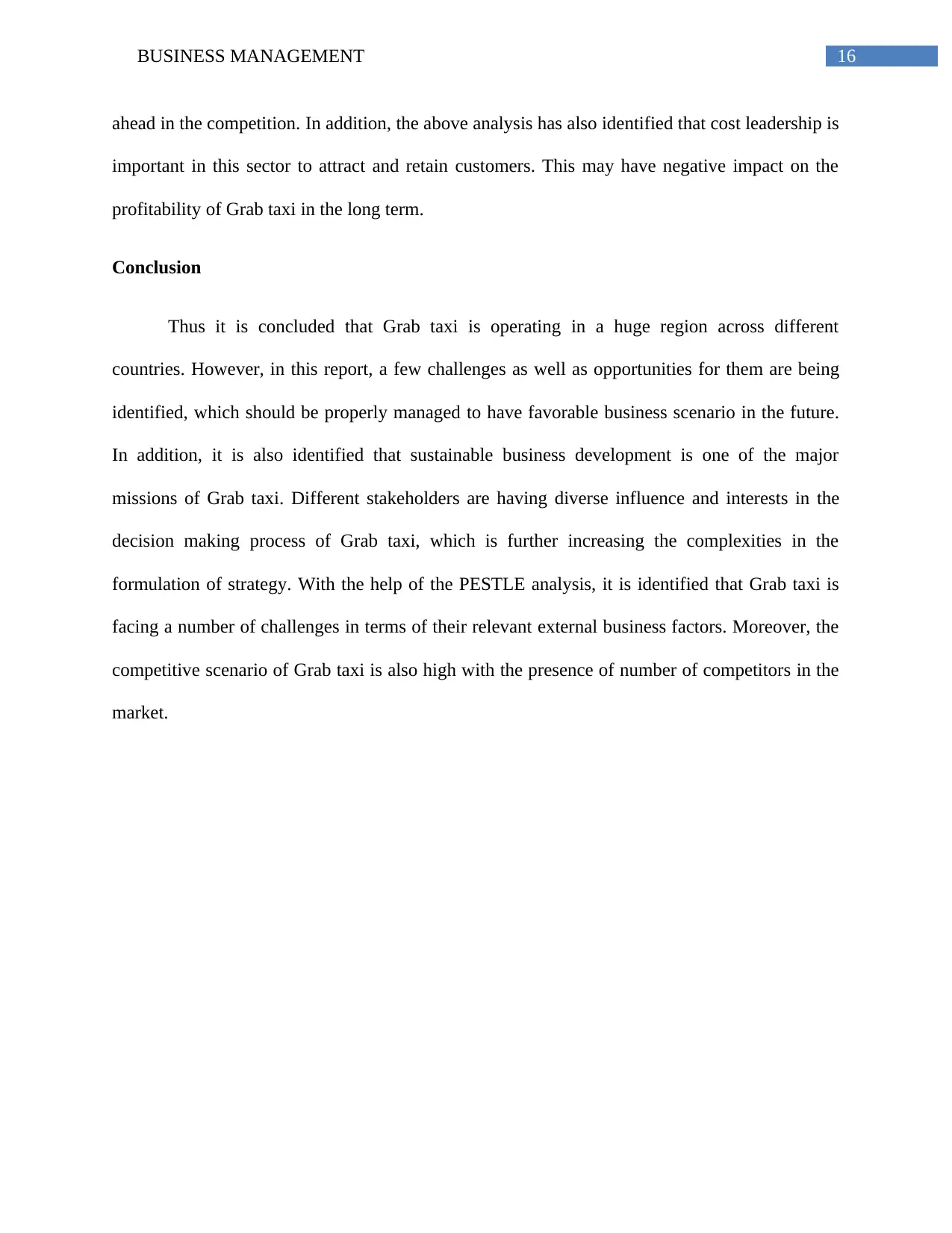
16BUSINESS MANAGEMENT
ahead in the competition. In addition, the above analysis has also identified that cost leadership is
important in this sector to attract and retain customers. This may have negative impact on the
profitability of Grab taxi in the long term.
Conclusion
Thus it is concluded that Grab taxi is operating in a huge region across different
countries. However, in this report, a few challenges as well as opportunities for them are being
identified, which should be properly managed to have favorable business scenario in the future.
In addition, it is also identified that sustainable business development is one of the major
missions of Grab taxi. Different stakeholders are having diverse influence and interests in the
decision making process of Grab taxi, which is further increasing the complexities in the
formulation of strategy. With the help of the PESTLE analysis, it is identified that Grab taxi is
facing a number of challenges in terms of their relevant external business factors. Moreover, the
competitive scenario of Grab taxi is also high with the presence of number of competitors in the
market.
ahead in the competition. In addition, the above analysis has also identified that cost leadership is
important in this sector to attract and retain customers. This may have negative impact on the
profitability of Grab taxi in the long term.
Conclusion
Thus it is concluded that Grab taxi is operating in a huge region across different
countries. However, in this report, a few challenges as well as opportunities for them are being
identified, which should be properly managed to have favorable business scenario in the future.
In addition, it is also identified that sustainable business development is one of the major
missions of Grab taxi. Different stakeholders are having diverse influence and interests in the
decision making process of Grab taxi, which is further increasing the complexities in the
formulation of strategy. With the help of the PESTLE analysis, it is identified that Grab taxi is
facing a number of challenges in terms of their relevant external business factors. Moreover, the
competitive scenario of Grab taxi is also high with the presence of number of competitors in the
market.
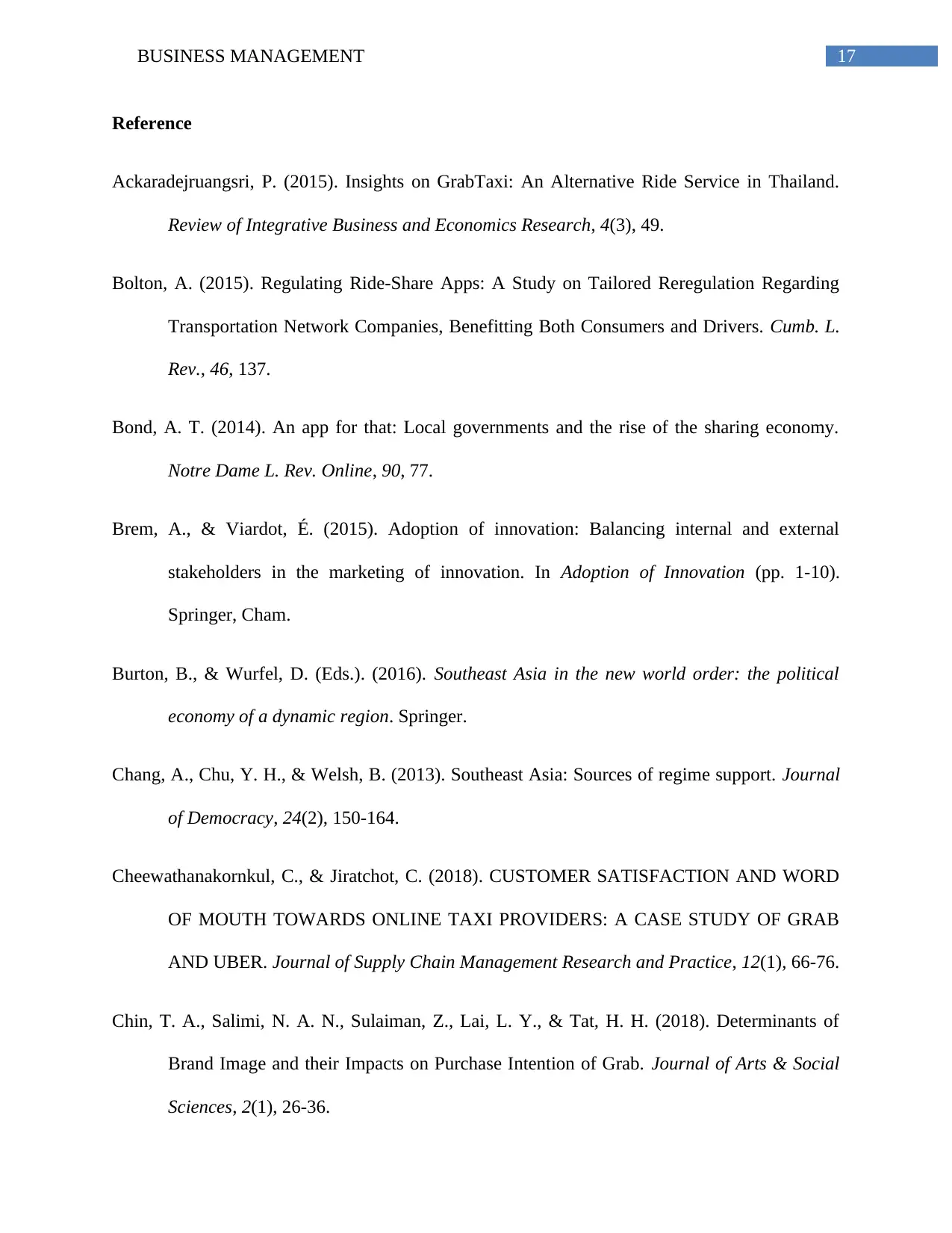
17BUSINESS MANAGEMENT
Reference
Ackaradejruangsri, P. (2015). Insights on GrabTaxi: An Alternative Ride Service in Thailand.
Review of Integrative Business and Economics Research, 4(3), 49.
Bolton, A. (2015). Regulating Ride-Share Apps: A Study on Tailored Reregulation Regarding
Transportation Network Companies, Benefitting Both Consumers and Drivers. Cumb. L.
Rev., 46, 137.
Bond, A. T. (2014). An app for that: Local governments and the rise of the sharing economy.
Notre Dame L. Rev. Online, 90, 77.
Brem, A., & Viardot, É. (2015). Adoption of innovation: Balancing internal and external
stakeholders in the marketing of innovation. In Adoption of Innovation (pp. 1-10).
Springer, Cham.
Burton, B., & Wurfel, D. (Eds.). (2016). Southeast Asia in the new world order: the political
economy of a dynamic region. Springer.
Chang, A., Chu, Y. H., & Welsh, B. (2013). Southeast Asia: Sources of regime support. Journal
of Democracy, 24(2), 150-164.
Cheewathanakornkul, C., & Jiratchot, C. (2018). CUSTOMER SATISFACTION AND WORD
OF MOUTH TOWARDS ONLINE TAXI PROVIDERS: A CASE STUDY OF GRAB
AND UBER. Journal of Supply Chain Management Research and Practice, 12(1), 66-76.
Chin, T. A., Salimi, N. A. N., Sulaiman, Z., Lai, L. Y., & Tat, H. H. (2018). Determinants of
Brand Image and their Impacts on Purchase Intention of Grab. Journal of Arts & Social
Sciences, 2(1), 26-36.
Reference
Ackaradejruangsri, P. (2015). Insights on GrabTaxi: An Alternative Ride Service in Thailand.
Review of Integrative Business and Economics Research, 4(3), 49.
Bolton, A. (2015). Regulating Ride-Share Apps: A Study on Tailored Reregulation Regarding
Transportation Network Companies, Benefitting Both Consumers and Drivers. Cumb. L.
Rev., 46, 137.
Bond, A. T. (2014). An app for that: Local governments and the rise of the sharing economy.
Notre Dame L. Rev. Online, 90, 77.
Brem, A., & Viardot, É. (2015). Adoption of innovation: Balancing internal and external
stakeholders in the marketing of innovation. In Adoption of Innovation (pp. 1-10).
Springer, Cham.
Burton, B., & Wurfel, D. (Eds.). (2016). Southeast Asia in the new world order: the political
economy of a dynamic region. Springer.
Chang, A., Chu, Y. H., & Welsh, B. (2013). Southeast Asia: Sources of regime support. Journal
of Democracy, 24(2), 150-164.
Cheewathanakornkul, C., & Jiratchot, C. (2018). CUSTOMER SATISFACTION AND WORD
OF MOUTH TOWARDS ONLINE TAXI PROVIDERS: A CASE STUDY OF GRAB
AND UBER. Journal of Supply Chain Management Research and Practice, 12(1), 66-76.
Chin, T. A., Salimi, N. A. N., Sulaiman, Z., Lai, L. Y., & Tat, H. H. (2018). Determinants of
Brand Image and their Impacts on Purchase Intention of Grab. Journal of Arts & Social
Sciences, 2(1), 26-36.
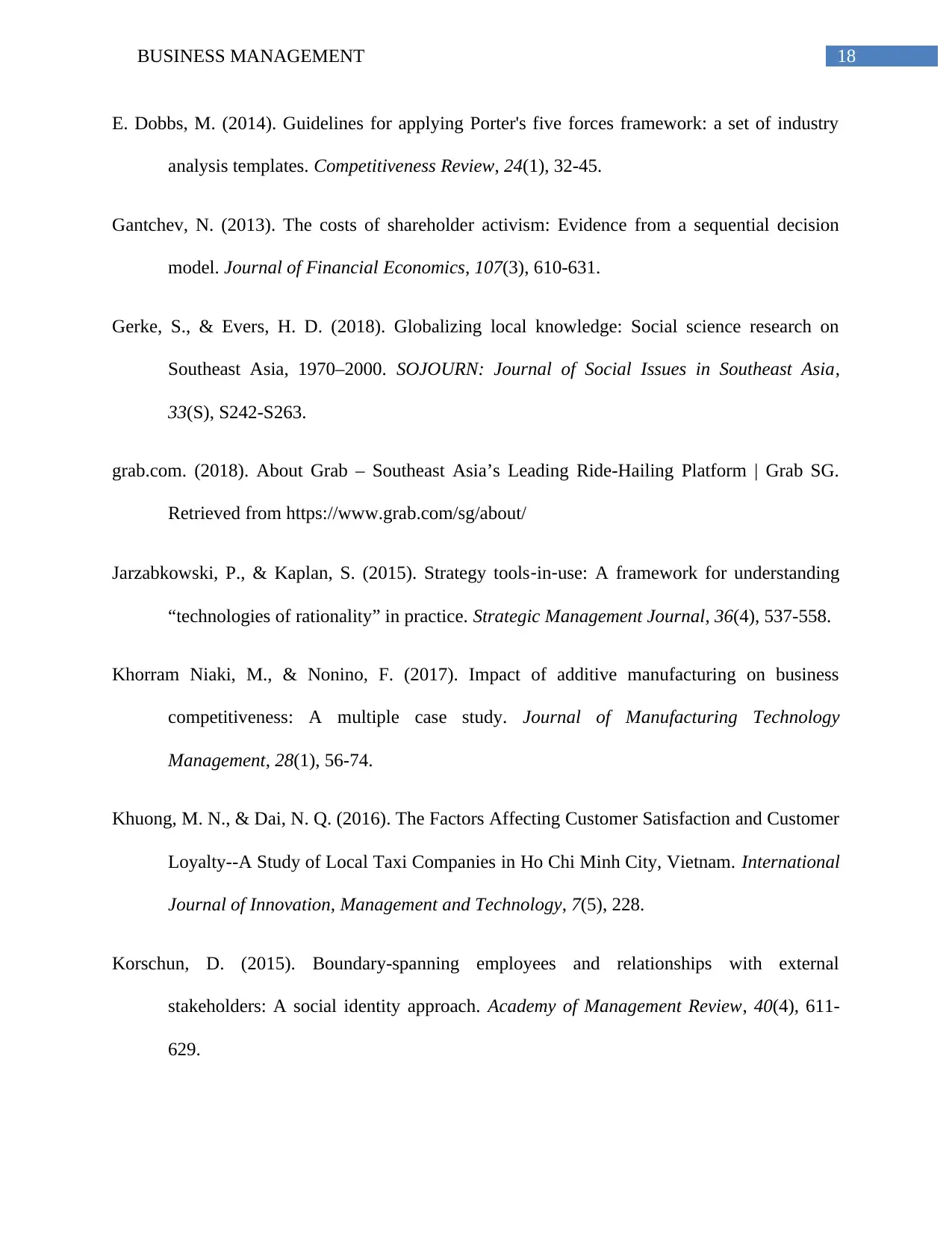
18BUSINESS MANAGEMENT
E. Dobbs, M. (2014). Guidelines for applying Porter's five forces framework: a set of industry
analysis templates. Competitiveness Review, 24(1), 32-45.
Gantchev, N. (2013). The costs of shareholder activism: Evidence from a sequential decision
model. Journal of Financial Economics, 107(3), 610-631.
Gerke, S., & Evers, H. D. (2018). Globalizing local knowledge: Social science research on
Southeast Asia, 1970–2000. SOJOURN: Journal of Social Issues in Southeast Asia,
33(S), S242-S263.
grab.com. (2018). About Grab – Southeast Asia’s Leading Ride-Hailing Platform | Grab SG.
Retrieved from https://www.grab.com/sg/about/
Jarzabkowski, P., & Kaplan, S. (2015). Strategy tools‐in‐use: A framework for understanding
“technologies of rationality” in practice. Strategic Management Journal, 36(4), 537-558.
Khorram Niaki, M., & Nonino, F. (2017). Impact of additive manufacturing on business
competitiveness: A multiple case study. Journal of Manufacturing Technology
Management, 28(1), 56-74.
Khuong, M. N., & Dai, N. Q. (2016). The Factors Affecting Customer Satisfaction and Customer
Loyalty--A Study of Local Taxi Companies in Ho Chi Minh City, Vietnam. International
Journal of Innovation, Management and Technology, 7(5), 228.
Korschun, D. (2015). Boundary-spanning employees and relationships with external
stakeholders: A social identity approach. Academy of Management Review, 40(4), 611-
629.
E. Dobbs, M. (2014). Guidelines for applying Porter's five forces framework: a set of industry
analysis templates. Competitiveness Review, 24(1), 32-45.
Gantchev, N. (2013). The costs of shareholder activism: Evidence from a sequential decision
model. Journal of Financial Economics, 107(3), 610-631.
Gerke, S., & Evers, H. D. (2018). Globalizing local knowledge: Social science research on
Southeast Asia, 1970–2000. SOJOURN: Journal of Social Issues in Southeast Asia,
33(S), S242-S263.
grab.com. (2018). About Grab – Southeast Asia’s Leading Ride-Hailing Platform | Grab SG.
Retrieved from https://www.grab.com/sg/about/
Jarzabkowski, P., & Kaplan, S. (2015). Strategy tools‐in‐use: A framework for understanding
“technologies of rationality” in practice. Strategic Management Journal, 36(4), 537-558.
Khorram Niaki, M., & Nonino, F. (2017). Impact of additive manufacturing on business
competitiveness: A multiple case study. Journal of Manufacturing Technology
Management, 28(1), 56-74.
Khuong, M. N., & Dai, N. Q. (2016). The Factors Affecting Customer Satisfaction and Customer
Loyalty--A Study of Local Taxi Companies in Ho Chi Minh City, Vietnam. International
Journal of Innovation, Management and Technology, 7(5), 228.
Korschun, D. (2015). Boundary-spanning employees and relationships with external
stakeholders: A social identity approach. Academy of Management Review, 40(4), 611-
629.
Paraphrase This Document
Need a fresh take? Get an instant paraphrase of this document with our AI Paraphraser
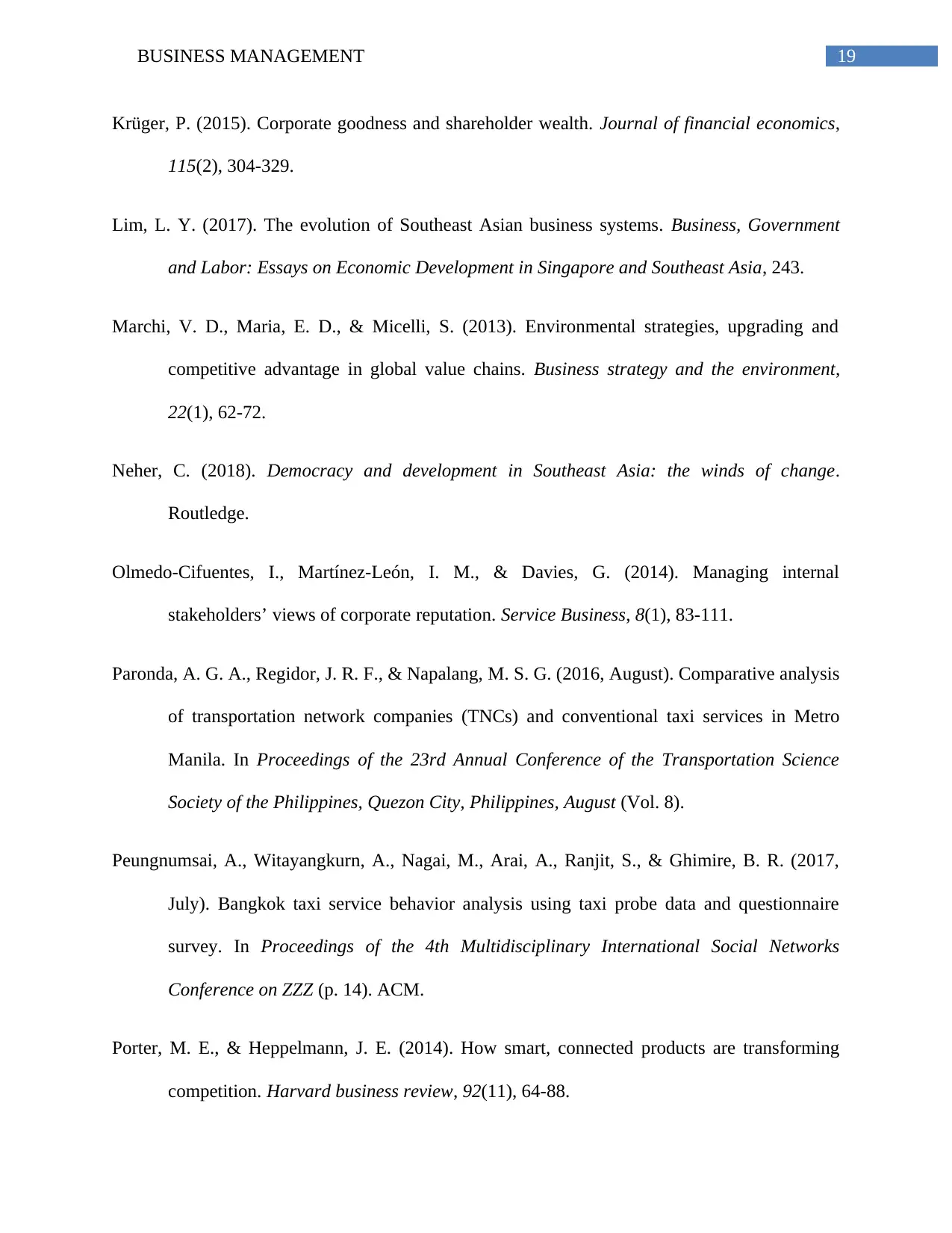
19BUSINESS MANAGEMENT
Krüger, P. (2015). Corporate goodness and shareholder wealth. Journal of financial economics,
115(2), 304-329.
Lim, L. Y. (2017). The evolution of Southeast Asian business systems. Business, Government
and Labor: Essays on Economic Development in Singapore and Southeast Asia, 243.
Marchi, V. D., Maria, E. D., & Micelli, S. (2013). Environmental strategies, upgrading and
competitive advantage in global value chains. Business strategy and the environment,
22(1), 62-72.
Neher, C. (2018). Democracy and development in Southeast Asia: the winds of change.
Routledge.
Olmedo-Cifuentes, I., Martínez-León, I. M., & Davies, G. (2014). Managing internal
stakeholders’ views of corporate reputation. Service Business, 8(1), 83-111.
Paronda, A. G. A., Regidor, J. R. F., & Napalang, M. S. G. (2016, August). Comparative analysis
of transportation network companies (TNCs) and conventional taxi services in Metro
Manila. In Proceedings of the 23rd Annual Conference of the Transportation Science
Society of the Philippines, Quezon City, Philippines, August (Vol. 8).
Peungnumsai, A., Witayangkurn, A., Nagai, M., Arai, A., Ranjit, S., & Ghimire, B. R. (2017,
July). Bangkok taxi service behavior analysis using taxi probe data and questionnaire
survey. In Proceedings of the 4th Multidisciplinary International Social Networks
Conference on ZZZ (p. 14). ACM.
Porter, M. E., & Heppelmann, J. E. (2014). How smart, connected products are transforming
competition. Harvard business review, 92(11), 64-88.
Krüger, P. (2015). Corporate goodness and shareholder wealth. Journal of financial economics,
115(2), 304-329.
Lim, L. Y. (2017). The evolution of Southeast Asian business systems. Business, Government
and Labor: Essays on Economic Development in Singapore and Southeast Asia, 243.
Marchi, V. D., Maria, E. D., & Micelli, S. (2013). Environmental strategies, upgrading and
competitive advantage in global value chains. Business strategy and the environment,
22(1), 62-72.
Neher, C. (2018). Democracy and development in Southeast Asia: the winds of change.
Routledge.
Olmedo-Cifuentes, I., Martínez-León, I. M., & Davies, G. (2014). Managing internal
stakeholders’ views of corporate reputation. Service Business, 8(1), 83-111.
Paronda, A. G. A., Regidor, J. R. F., & Napalang, M. S. G. (2016, August). Comparative analysis
of transportation network companies (TNCs) and conventional taxi services in Metro
Manila. In Proceedings of the 23rd Annual Conference of the Transportation Science
Society of the Philippines, Quezon City, Philippines, August (Vol. 8).
Peungnumsai, A., Witayangkurn, A., Nagai, M., Arai, A., Ranjit, S., & Ghimire, B. R. (2017,
July). Bangkok taxi service behavior analysis using taxi probe data and questionnaire
survey. In Proceedings of the 4th Multidisciplinary International Social Networks
Conference on ZZZ (p. 14). ACM.
Porter, M. E., & Heppelmann, J. E. (2014). How smart, connected products are transforming
competition. Harvard business review, 92(11), 64-88.
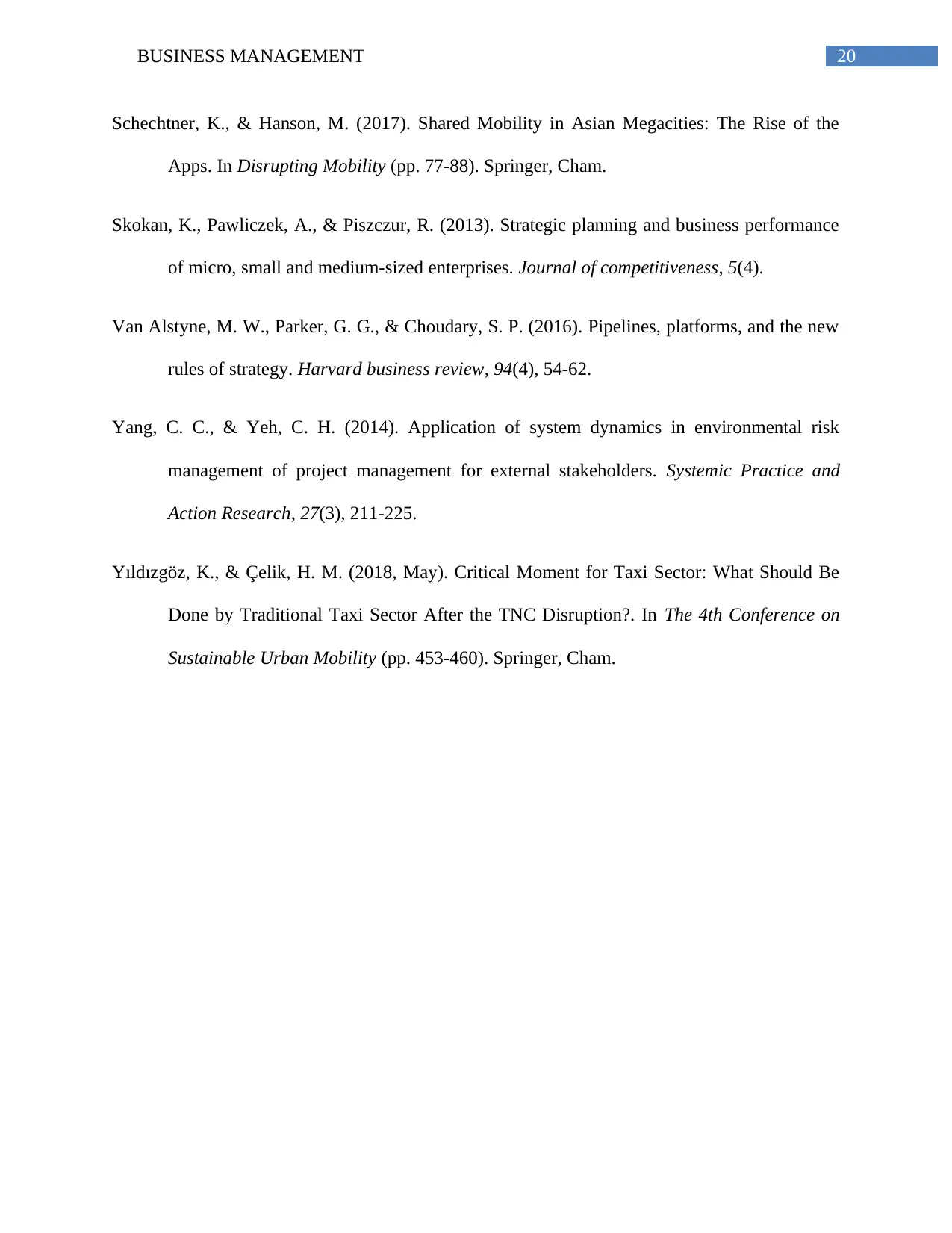
20BUSINESS MANAGEMENT
Schechtner, K., & Hanson, M. (2017). Shared Mobility in Asian Megacities: The Rise of the
Apps. In Disrupting Mobility (pp. 77-88). Springer, Cham.
Skokan, K., Pawliczek, A., & Piszczur, R. (2013). Strategic planning and business performance
of micro, small and medium-sized enterprises. Journal of competitiveness, 5(4).
Van Alstyne, M. W., Parker, G. G., & Choudary, S. P. (2016). Pipelines, platforms, and the new
rules of strategy. Harvard business review, 94(4), 54-62.
Yang, C. C., & Yeh, C. H. (2014). Application of system dynamics in environmental risk
management of project management for external stakeholders. Systemic Practice and
Action Research, 27(3), 211-225.
Yıldızgöz, K., & Çelik, H. M. (2018, May). Critical Moment for Taxi Sector: What Should Be
Done by Traditional Taxi Sector After the TNC Disruption?. In The 4th Conference on
Sustainable Urban Mobility (pp. 453-460). Springer, Cham.
Schechtner, K., & Hanson, M. (2017). Shared Mobility in Asian Megacities: The Rise of the
Apps. In Disrupting Mobility (pp. 77-88). Springer, Cham.
Skokan, K., Pawliczek, A., & Piszczur, R. (2013). Strategic planning and business performance
of micro, small and medium-sized enterprises. Journal of competitiveness, 5(4).
Van Alstyne, M. W., Parker, G. G., & Choudary, S. P. (2016). Pipelines, platforms, and the new
rules of strategy. Harvard business review, 94(4), 54-62.
Yang, C. C., & Yeh, C. H. (2014). Application of system dynamics in environmental risk
management of project management for external stakeholders. Systemic Practice and
Action Research, 27(3), 211-225.
Yıldızgöz, K., & Çelik, H. M. (2018, May). Critical Moment for Taxi Sector: What Should Be
Done by Traditional Taxi Sector After the TNC Disruption?. In The 4th Conference on
Sustainable Urban Mobility (pp. 453-460). Springer, Cham.
1 out of 21
Related Documents
Your All-in-One AI-Powered Toolkit for Academic Success.
+13062052269
info@desklib.com
Available 24*7 on WhatsApp / Email
![[object Object]](/_next/static/media/star-bottom.7253800d.svg)
Unlock your academic potential
© 2024 | Zucol Services PVT LTD | All rights reserved.




